Vol. 70, No. 18 (2021)
2021-09-20
YOUNG SCIENTISTS’ FORUM
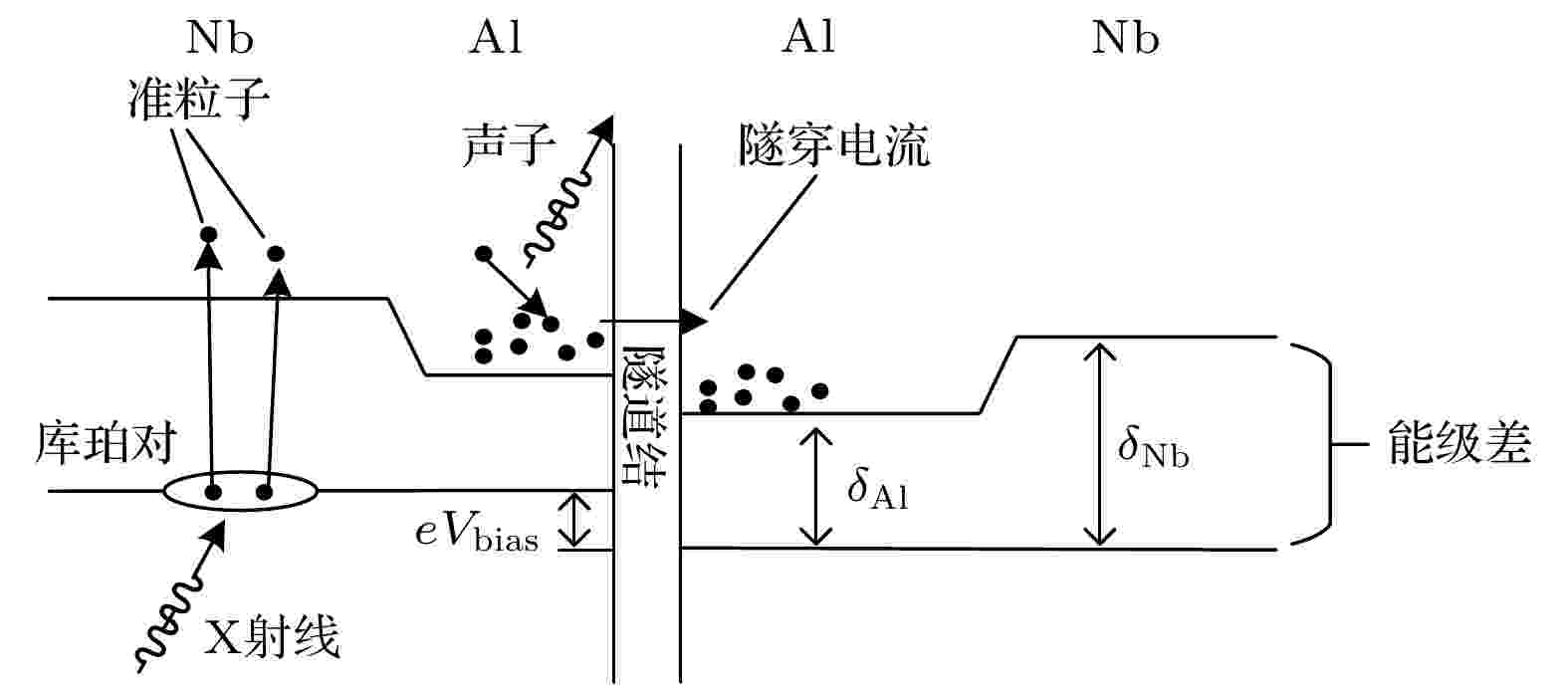
YOUNG SCIENTISTS' FORUM
2021, 70 (18): 180702.
doi: 10.7498/aps.70.20210350
Abstract +
Cryogenic X-ray spectrometers are advantageous in the spectrum research for weak and diffusive X-ray source due to their high energy resolution, high detection efficiency, low noise level and non-dead-layer properties. Their energy resolution independent of the incident X-ray direction also makes them competitive in diffusion source detection. The requirements for X-ray spectrometers have heightened in recent years with the rapid development of large scientific facilities where X-ray detection is demanded, including beamline endstations in synchrotron and X-ray free electron laser facilities, accelerators, highly charged ion traps, X-ray space satellites, etc. Because of their excellent performances, cryogenic X-ray detectors are introduced into these facilities, typical examples of which are APS, NSLS, LCLS-II, Spring-8, SSNL, ATHENA, HUBS. In this paper, we review the cryogenic X-ray spectrometers, from the working principle and classification, system structure, major performance characteristics to the research status and trend in large scientific facilities in the world.
REVIEW
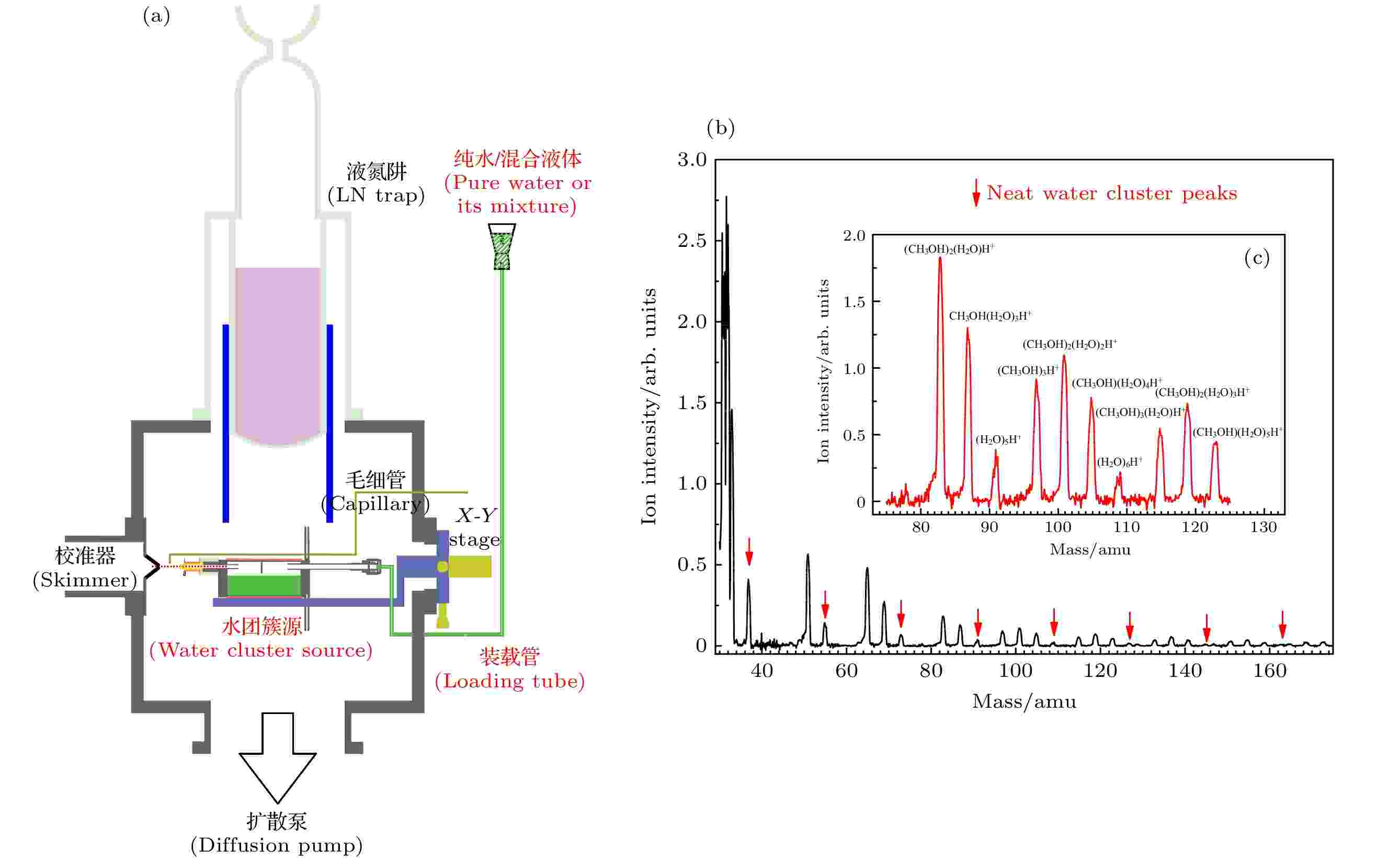
2021, 70 (18): 183601.
doi: 10.7498/aps.70.20210478
Abstract +
Water is one of the most common molecules in space and is also most valuable substance resource for living activities on earth. Studying water clusters plays an important role in actually utilizing water resources. Meanwhile, water clusters can be used as an ideal water microscopic model, which can expand the development of physical and chemical basic science, for example, it can provide the reference for investigating the size-dependent dissociation properties and interactions between solvents and solutes. On the other hand, the gas-phase mixed acidic water clusters have aroused great interest in recent years. For instance, One has been seeking for the smallest energy structure of pure water clusters and doped acidic molecular water clusters, experimentally and theoretically. In short, doping with foreign molecules or atoms can significantly enlarge the scope of scientific research on water clusters. Currently, there are many approaches to doping water clusters experimentally. This review briefly summarizes these means and compares the characteristics of various doping methods to help researchers to apply water cluster doping experiments more effectively.
GENERAL
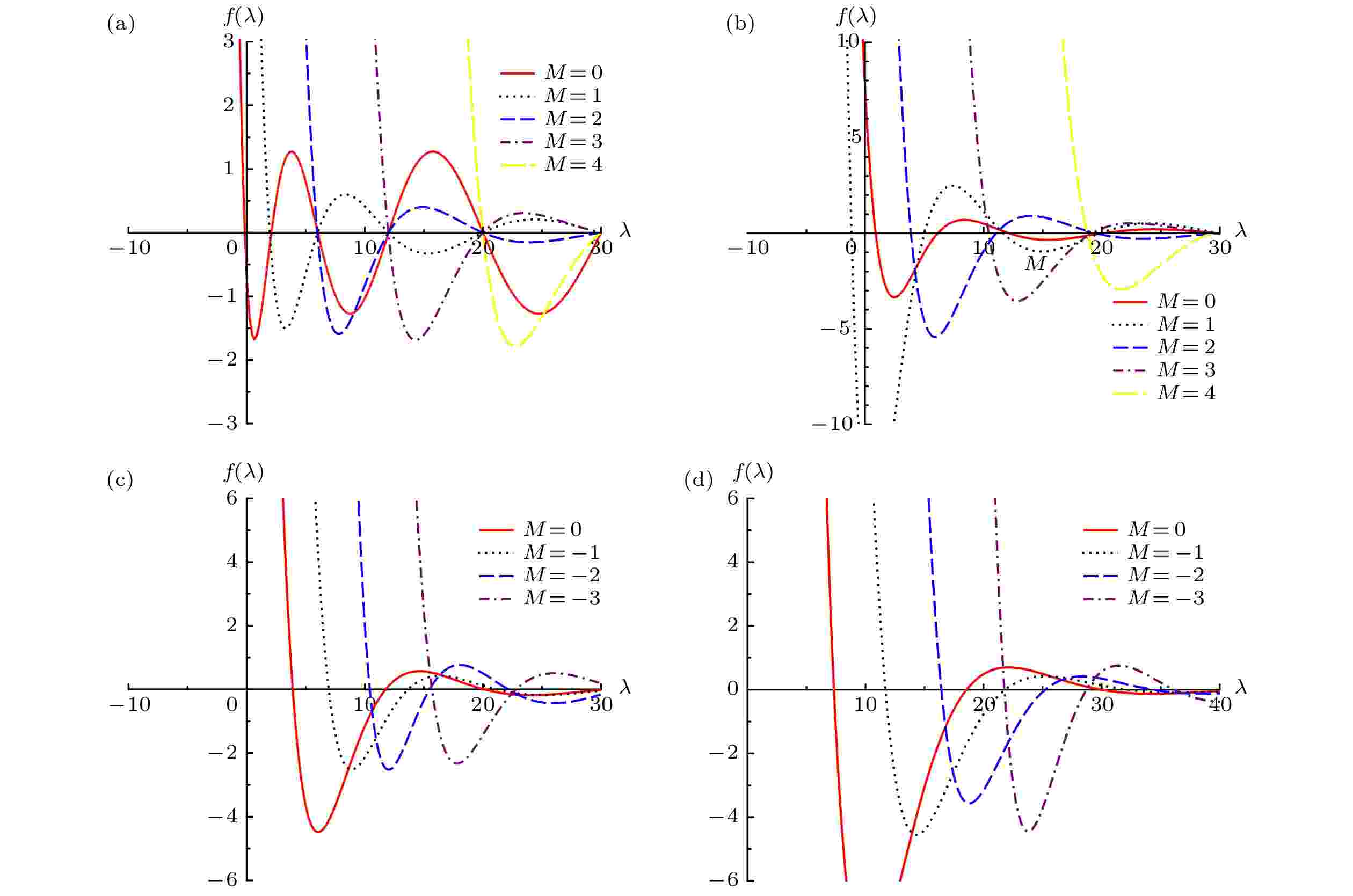
2021, 70 (18): 180301.
doi: 10.7498/aps.70.20210214
Abstract +
In this work a new scheme is proposed to accurately calculate the rotational energy level of the rigid symmetric-top molecule subjected to the external electric field, and also to obtain the corresponding analytical wave functions. For this purpose, first we use the different forms of function transformation and variable substitution to transform the differential equation of the polar angle θ into a confluent Heun differential equation, and then we use the characteristics of the confluent Heun differential equation and the confluent Heun function to find two linearly dependent solutions of the same eigenstates, which are used to construct the Wronskian determinant to obtain the exact energy spectrum equation. Finally, with the aid of the Maple software, we calculate the eigenvalues for different quantum states, and then substitute the obtained eigenvalues into the unnormalized eigenfunction to obtain the analytical normalized eigenfunction expressed by the confluent Heun function. These results are conducive to the in-depth study of the Stark effect of symmetric-top molecules.
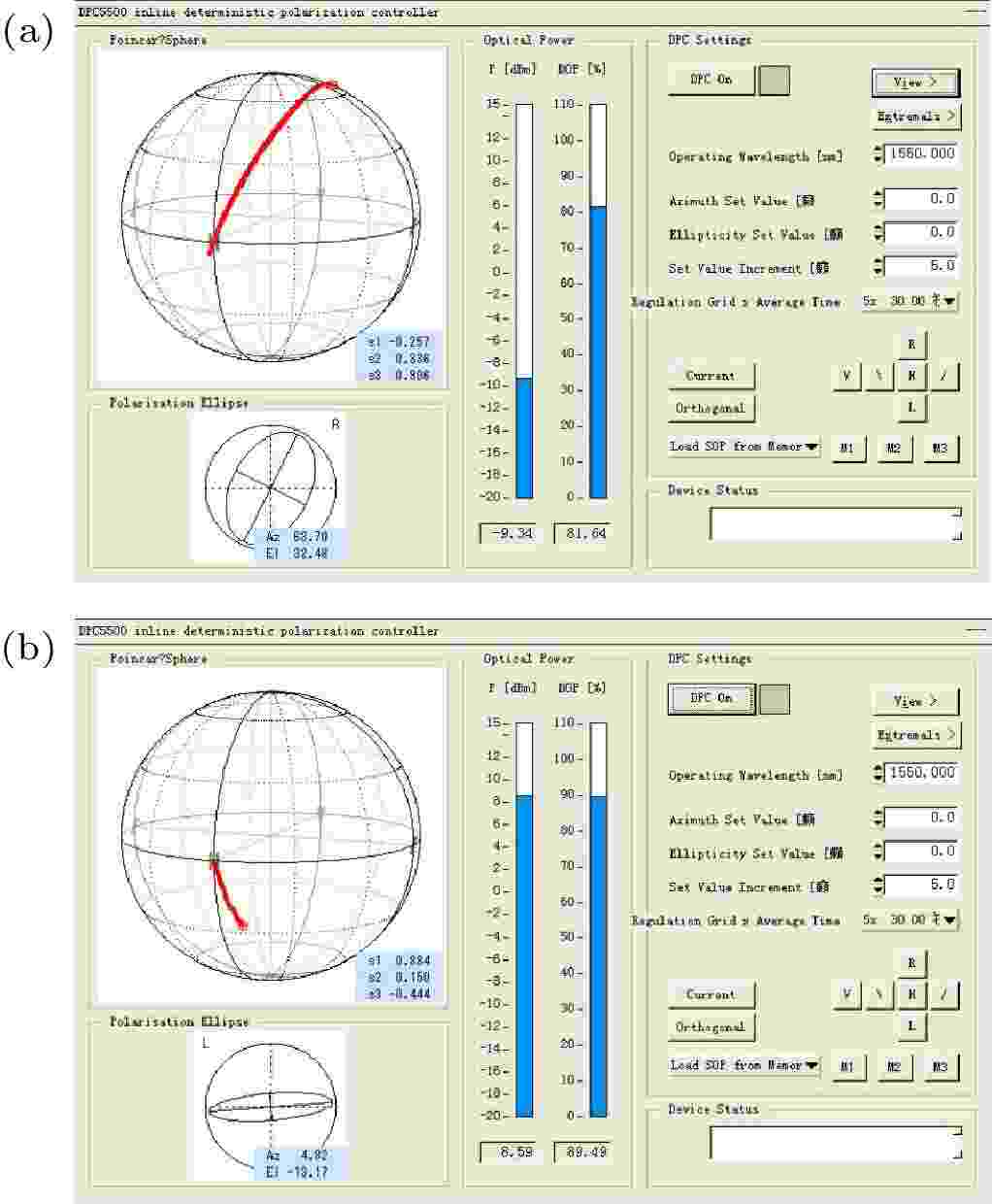
2021, 70 (18): 180302.
doi: 10.7498/aps.70.20210749
Abstract +
A free-space quantum key distribution (QKD) system based on mobile equipment can provide an effective method to construct a real-time full-coverage multi-node network. However, the existing free-space QKD systems based on mobile devices encounter the challenge regarding the lack of stability caused by equipment disturbance. The robustness of the QKD polarization encoder against mobile device disturbance will be significant. Owing to the inevitable disturbance in practical applications, even the polarization-maintaining fiber (PMF) cannot maintain its polarization-maintaining characteristics well, which in turn affects the stability of some systems based on PMF. Therefore, in order to ensure that stable coding can be achieved under disturbances, we propose a two-way differential modulation mode, in which stable coding can still be achieved even under disturbances. At the same time, in order to verify the actual anti-disturbance characteristics of the mode, the polarization-modulated unit (PMU) with a two-way differential modulation mode is used in this study to generate four long-term stable polarization states subjected to the disturbances with a frequency of 200 Hz. At the same time, the PMU has a higher insertion loss, which makes the influence of crosstalk on the system more obvious. We also discuss two ways i.e. the time domain and frequency domain, to reduce the crosstalk which is caused by the imperfection of the device. The experiment is performed at a repetition frequency of 250 MHz, and a commercial avalanche single-photon detector is used to detect the system’s quantum bit error rate (QBER). Under the condition of no disturbance, the average QBER is 0.39% in 2 h. Then a vibration of approximately 200 Hz is used to simulate the practical disturbances, the average QBER is 0.36% in 2 h, and the fluctuation range of the QBER is only within 0.2%. We propose the first feasible encoding scheme in disturbed environments to ensure the long-term stability of the encoded polarization states, which is expected to be used in the multi-node expansion of the quantum network.
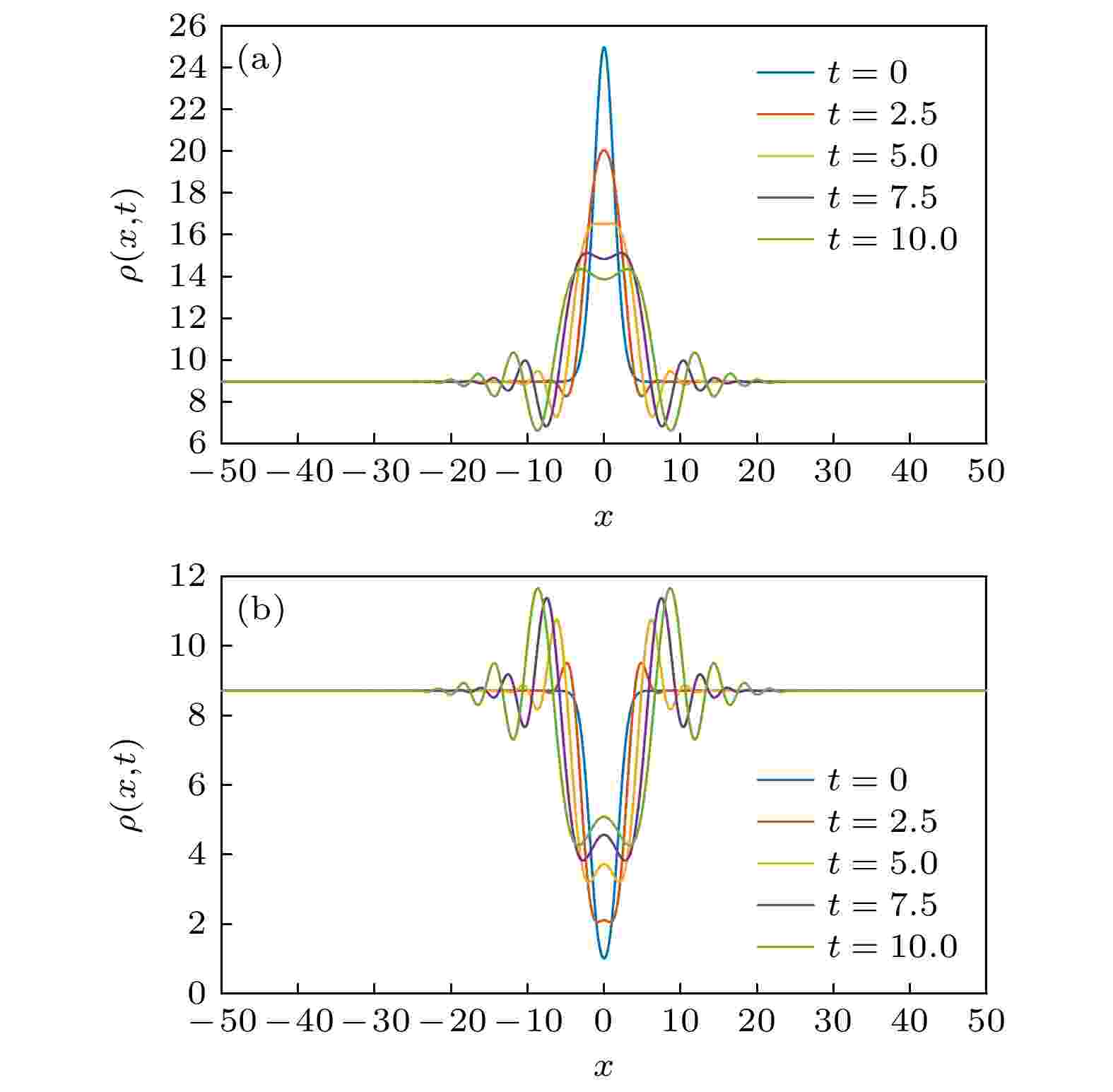
2021, 70 (18): 180303.
doi: 10.7498/aps.70.20210564
Abstract +
The Bose-Einstein condensate (BEC) formed by ultracold atomic gases provides an ideal platform for studying various quantum phenomena. In this platform, researchers have explored in depth the important equilibrium and steady phenomena including superfluidity, vortices, and solitons, and recently started to study nonequilibrium problems. In a classical system, nonequilibrium problems, such as explosion, usually occur together with shock waves, which is presented when the explosion speed is larger than the local sound speed. For BEC systems which possess quantum properties, how to produce and understand the shock waves becomes a hot research topic. In this work, we systematically discuss the possibility of quantum shock wave and its essential mechanism in a one-dimensional BEC initially containing dark solitons through quenching interactions. When the system is quenched to the limit of non-interaction, we analytically obtain the post-quench dynamics of initially immobile dark solitons, and find the existence of shock wave, which can be explained through the quantum interference effect. When the system is quenched to finite interaction, we find similar phenomena through numerically solving the Gross-Pitaevskii equation, and analyze different situations. When the system is quenched to a finite weaker interaction, the situation is similar to a non-interaction case; when the system is quenched to a stronger interaction, the shock wave is accompanied by the splitting of the initial soliton, and the two objects can synchronously change; specifically when the quenched ratio of strength is an integer squared, the shock wave disappears, and the soliton is split perfectly. We further explore the properties of the shock wave including its amplitude and speed, and obtain the full scenario as the quenched interaction varies. This work provides theoretical guidance for realizing and measuring shock wave in experiment.
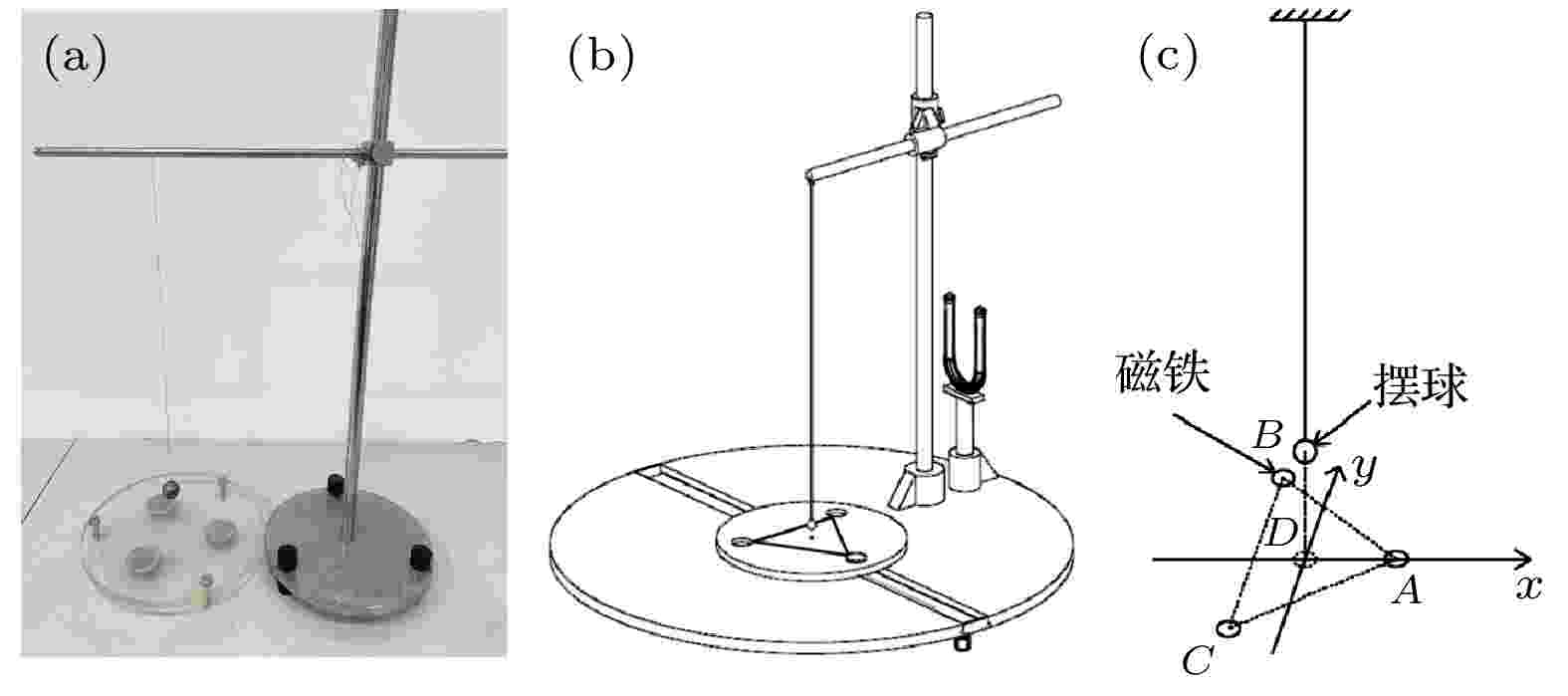
2021, 70 (18): 180501.
doi: 10.7498/aps.70.20210524
Abstract +
Based on the analysis of the global dynamic behavior of a typical magnetic pendulum with equilateral triangular arrangement, the initial sensitivity and its mechanism are studied. To begin with, assuming that the position of the magnet can be moved, the dynamical model of a typical magnetic pendulum is established via Newton’s second law. Furthermore, the number of equilibrium points under different magnet positions and their stability are analyzed. Upon this, the initial sensitivity phenomenon and the evolution of fractal basin of attraction of point attractors under different magnet positions are presented. Finally, the initial sensitivity phenomenon is verified experimentally. It is found that the coexistence of multiple attractors generally appears in this type of magnetic pendulum. The initial sensitivity can be attributed to the fractal basin of attraction of fixed point attractors, in which the positions of the fixed point attractors do not overlap with the projected positions of the center of the magnet on the plane where the magnet is located, but there is a slight deviation. When the position of the swing ball can be projected onto the centroids of three equilateral triangles corresponding to the magnets, the sizes of the three attractors’ attraction domains will be similar, whose boundaries are fractal and centrosymmetric, thus, the initial sensitivity is obvious. It also follows that the position of moving magnet affects the nature of basin of attraction directly, i.e., the magnet which is closest to the projection point of the balance position of the swing ball has a great influence on the swing ball: the domain of attraction of the attractor whose is the closest to the position will increase significantly, while the attractor domains of the other attractors will be eroded obviously. This paper has potential applications in designing the magnetic pendulum systems.

2021, 70 (18): 180502.
doi: 10.7498/aps.70.20210728
Abstract +
Nonequilibrium dynamics of quantum many-body systems have achieved rapid progress from both theoretical and experimental perspectives. Recently, dynamical quantum phase transitions (DQPTs), which describe the nonanalytic behaviors of physical quantities during the time evolution, have attracted a lot of interest. The most studied protocol to drive the system out of equilibrium is via a quantum quench. Recently, the DQPTs in the Ising chain and ANNNI chain after double quench are studied. Double quench means that the Hamiltonian of the system is abruptly changed from $H_{0}$ to $H_{1}$ , and then abruptly changed from $H_{1}$ to $H_{2}$ after a evolutionary time T. One can control at will whether or not DQPTs appear after the second quench by varying T. In this paper, we study the DQPTs arising from a double quench in the anisotropic $XY$ chain in a transverse field. The anisotropic $XY$ chain in a transverse field has two kinds of quantum phase transitions (Ising transition and anisotropic transition). We discuss mainly the effects of quench paths on the DQPTs of the transverse field $XY$ chain. By calculating the rate function of the Loschmidt echo and Fisher zeros, we find that there are three typical types of the critical times of DQPTs in the plane of the T and the evolution time t. Type I of critical times, which occurs only in a certain range of T, is related to the protocol of the Hamiltonian abruptly changed from $H_{0}$ to $H_{1}$ . Type II of critical times, which occurs all the time, is related to the protocol of the Hamiltonian abruptly changed from $H_{0}$ to $H_{2}$ . Type III of critical times, which occurs all the time, is related to the protocols of the Hamiltonian abruptly changed from $H_{0}$ to $H_{1}$ and $H_{0}$ to $H_{2}$ . When the double quench paths pass through the same kind of transition point, only the critical times corresponding to Type I will appear after the second quench. When the double quench paths pass through different kinds of transition points, the critical times after the second quench will appear any two of the above three types, which depend on the choice of quench path.

2021, 70 (18): 180601.
doi: 10.7498/aps.70.20210565
Abstract +
Absolute distance measurement based on the asynchronous optical sampling with using a dual-comb system has the characteristics of large range, fast measurement speed, and high accuracy, which has wide application prospects in the field of precision measurement of geometric quantities, such as the space technology, equipment manufacturing, etc. Recently, the invention of the femtosecond frequency comb is a milestone in the field of precision length measurement. Many approaches to the absolute distance measurement have been proposed. Among them, the dual-comb system with asynchronous optical sampling can realize a length measurement with fast speed, high accuracy, and long range. Especially, the temporal method combining the asynchronous optical sampling with nonlinear intensity cross-correlation can effectively avoid influencing of the carrier-envelope offset frequency on the ranging accuracy in the measurement process. The time-of-flight information can be obtained by the time interval between the reference pattern and the measurement pattern. Even so, the selection of the repetition rate and the difference of repetition rates will strongly influence the temporal sampling interval of the measurements. Therefore, the theoretical model and key parameters for the ranging are numerically studied for the non-linear asynchronous optical sampling by using a dual-comb system of absolute distance measurement. After analysis, the effects of source parameters (repetition frequency and repetition frequency difference), fine fitting of second harmonic signal, and timing jitter on ranging accuracy are studied respectively. The numerical analysis results show that the method of choosing a reasonable repetition frequency and repetition frequency difference is beneficial to the improvement of the ranging accuracy. When the sampling interval of the dual-comb system is a constant, the time value between the reference and measurement patterns can be obtained by the interpolation method of fine curve fitting, and it will further improve the ranging accuracy. In addition, the time jitter of the femtosecond pulses is also an important factor that can affect the ranging accuracy. By changing the difference in the repetition rate, the measurement speed can also be improved. After that, the cumulative ranging error caused by time jitter can be reduced. Therefore, the appropriate increasing of measurement speed can effectively reduce the influence of timing jitter on ranging.

EDITOR'S SUGGESTION
2021, 70 (18): 180602.
doi: 10.7498/aps.70.20210243
Abstract +
Atomic clocks provide the most accurate definition for time. The precision of atomic clock has been improved by many orders of magnitude since the first atomic clock was built. However, the interatomic interaction usually suppress the precision of atomic clock. As a result, it is especially meaningful to study the interaction effect in atomic clock, which is considered to be helpful in improving the precision and accuracy of atomic clock. In order to characterize the collision effect induced clock shift, we theoretically study the collision clock shift in the Rabi spectrum, caused by the short-range interaction between two Fermi atoms in harmonic potential. Given that the short-range interatomic interaction is generally weak, and that the parameters of external lattice laser field are in the Lamb-Dicke regime, we make an approximation that the spatial wave-function of the Fermi atoms does not change, and then derive the motion equation for the internal wave-function under the external Rabi driving field. We solve the equation of motion by the perturbative method, and obtain the solution to first order, and thus derive the expression of the collision clock shift of the Rabi spectrum in terms of the interatomic interaction and the external Rabi driving laser field parameters for specific spatial wave-functions of atoms. Finally, we use the exact expression of the Green’s function in harmonic potential to obtain the averaged clock shift of collision at finite temperatures. Our results relate the atomic interaction with atomic clock shift, and provide a unified description of all partial waves of atomic interaction induced clock shift. Therefore, it becomes much more convenient to study the contributions of different partial waves to atomic clock shift. On the other hand, our results indicate that through precisely measuring the clock shift, the information about the interatomic interactions can also be obtained. In addition, our results for two interacting atoms can inspire the future study of real many-body interacting system which will be the next research topic.

Discharge model and plasma characteristics of high-power pulsed magnetron sputtering titanium target
2021, 70 (18): 180701.
doi: 10.7498/aps.70.20202050
Abstract +
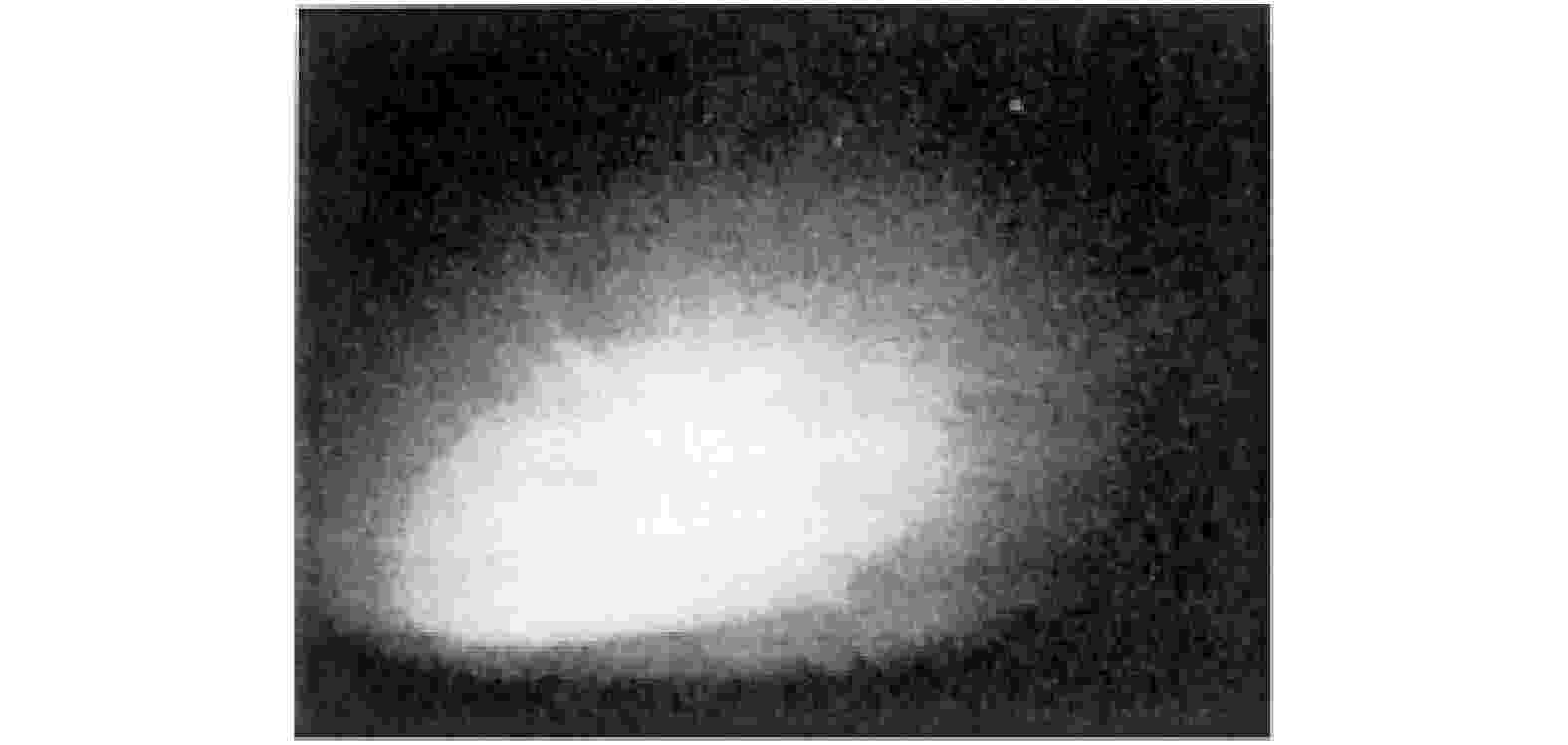
2021, 70 (18): 180703.
doi: 10.7498/aps.70.20210347
Abstract +
A Hydro-Magneto-PIC (particle-in-cell) hybrid model is proposed to describe the motion of the fission debris in high altitude nuclear explosions (HANEs). Compared with the state-of-art numerical models, our model is able to stably compute the motion of the fission debris in a broader spatial region. In a real HANE, the physical process contains many spatial scales. The upward moving debris particles manifest kinetic properties due to the fact that the dilute ambient atmosphere and the downward expanding particles manifest a fluid-like pattern and can be approximated by the usual hydro-dynamical models. Meanwhile, the debris particles receive electromagnetic forces from both the geomagnetic fields and the charged particles at all frequencies. This broad scale of frequencies can induce large- and small-scale instabilities, which cannot be solved by the usual hydrodynamic equations. Considering the motions of the debris and the different properties of the high temperature ions, the low temperature ions and the neutral atmosphere, we consistently combine three models for completely describing the debris expansion. The high temperature ions are described by the PIC model for their intrinsic kinetic behaviors, the low temperature ions are described by the magneto-hydrodynamic model for their fluid property, and fluid equations are applied to the neutral particles with no electromagnetic force. The corresponding interactions among the three components are added into the equations as the source terms. With the combination of the three models, our algorithm can stably calculate the regions that are a few thousand kilometers in altitude. Our proposed model contains both the kinetic and fluid properties, and is stable in numerical implementations. Finally, we calculate the debris motion in the Starfish experiment. The results confirm a consistency of our proposed model with the observations. The spatial scale of our simulation results is consistent with the result in the Starfish experiment. In addition, we also plot the distribution of the debris with different projection angles at various snapshots. These results give us an intuition to understand the influence of the various factors, such as the friction of atmosphere, the magnetic pressure, flute instability and the Hall currents. Our model provides a tool for implementing the HANE simulation in a broader scheme, and can also be utilized in other plasma systems.
ATOMIC AND MOLECULAR PHYSICS
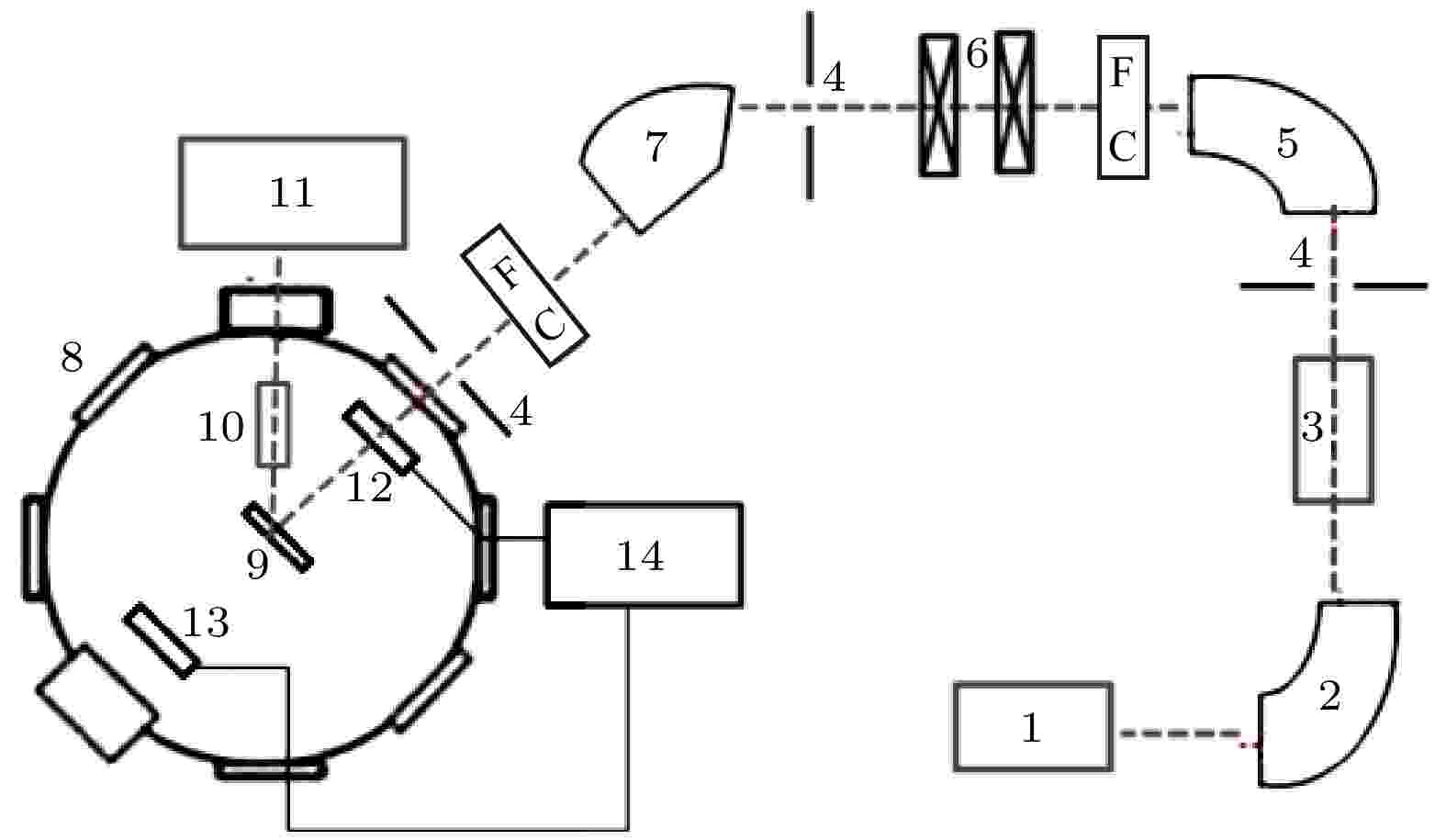
2021, 70 (18): 183201.
doi: 10.7498/aps.70.20210215
Abstract +
ELECTROMAGNETISM, OPTICS, ACOUSTICS, HEAT TRANSFER, CLASSICAL MECHANICS, AND FLUID DYNAMICS

2021, 70 (18): 184201.
doi: 10.7498/aps.70.20210217
Abstract +
Under different ambient temperatures, the thermal aberration certainly affects the imaging quality of infrared multi-spectral camera. Therefore, an athermalized model of infrared multi-spectral cameras is established, and in this model the ambient infrared multispectral camera is equivalent to a separated dual-lens optical system. In the case of the fixed focal length, the influence of the back focal length on the change of the focal power of the front lens and back lens is analyzed. Now, the variation range of the front and rear lens interval is assumed to be restricted. When the back focal length is smaller than the focal length, the ratio of the absolute value of the focal power of the front lens to the absolute value of the focal power of the back lens decreases with the back focal length increasing. The material of the front lens and the back lens have a longer interval on the thermogram. When the back focal length is greater than the focal length, the scenario becomes exactly opposite. Combined with the judgment method of the positive value and negative value of the focal power on the thermogram, the selection range of materials is constrained by the positive value, negative value, and absolute value of focal power, thus realizing the rapid selection of the optical materials. This method is used to design an athermalized infrared multispectral camera with a waveband of 8–14 μm, a focal length of 50 mm, and an F number of 1.4 in a range from –40 ℃ to +60 ℃. Through the simulation analysis, the value of the athermalized infrared multispectral camera, at the Nyquist frequency of 30 lp/mm reaches 0.39, which is close to the diffraction limit; the root mean square radius of the diffuse spot is smaller than the Airy spot radius of 19.17 μm; the axial aberration is less than 0.02 mm, and the design results show that this method can make the long back-focus infrared optical system maintain stable imaging quality in a large temperature range. The SF6 gas is detected experimentally, and the experimental results demonstrate the excellent optical performance of the system.

2021, 70 (18): 184202.
doi: 10.7498/aps.70.20202104
Abstract +
Temporal shearing interferometry is proposed to measure the temporal phase distribution of nanosecond laser pulses. In the proposed scheme, the pulse to be measured is divided into two pulses with a delay of hundreds of picoseconds in between, arbitrary one of the two pulses is added to by an appropriate amount of frequency shift, then is combined with the remaining pulse, thereby obtaining the temporal shearing interferogram that is recorded by a normal photodiode. The temporal phase distribution is calculated by an adaptive algorithm based on Fourier transform, and further the precise spectra of the measured pulse can also be calculated according to the Fourier relation between time domain and spectral domain. Based on the systematic analysis of the principle of the technology, the proposed technology is verified by numerical simulation. And the influence of the variable parameters including noise, relative delay, relative intensity on the measured error are systematically analyzed in the simulation. And the results show that the proposed nanosecond temporal phase diagnostic technique has a good performance when the signal noise ratio of the interferogram is above 15 dB, the relative delay of the pulses is between 0.5% and 28% and the relative intensity is above 0.1%. The proposed method is verified experimentally in a nanosecond laser system with central wavelength of 640 nm and pulse width of 20 ns. And the calculated spectra obtained from the temporal shearing interferogram match well with the spectra measured by a scanning Fabry-Perot interferometer. This proposed technique does not use any nonlinear optical effects, thus it can be applied to the diagnostic of nanosecond laser pulse centered at any wavelength. Hence, it provides a simple experimental setup for implementing the higher-accuracy diagnostic of the temporal phase distribution of nanosecond laser pulses.

2021, 70 (18): 184203.
doi: 10.7498/aps.70.20210449
Abstract +
In this paper, an orthogonally polarized dual-wavelength laser based on dual-end pumped Nd3+ doped MgO:LiNbO3 is reported. Besides, the output wavelength of the orthogonally polarized dual-wavelength is regulated. According to the crystal character, the polarized fluorescence spectrum of the crystal is chosen as the starting point. The oscillation mechanism of the dual-wavelength Nd3+ doped MgO:LiNbO3 laser at 1084 nm and 1093 nm is analyzed theoretically. The relationship between the focal length of the crystal thermal lens and the stimulated emission cross-sectional ratio is established, and the effects of different temperatures on the output of single-wavelength Nd3+ doped MgO:LiNbO3 laser and on the output of dual-wavelength Nd3+ doped MgO:LiNbO3 laser are analyzed. In addition, The single-wavelength output region of 1084 nm and 1093 nm are derived respectively, and the mixed dual-wavelength working area at 1084 nm and 1093 nm are also given. The influences of different resonator parameters on the output dual-wavelength Nd3+ doped MgO:LiNbO3 laser are analyzed. It is worth mentioning that a method of adjusting the output of dual-wavelength laser by changing the resonant cavity structure is given. In the experiment, a-cut Nd:MgO:LiNbO3 crystal is double-end pumped by an semiconductor laser, of which the output wavelength is 813 nm. The output law of the two wavelengths of 1084 nm and 1093 nm is summarized. The output wavelength is regulated. When the laser cavity is not inserted by other optical elements, the maximum output power of 4.58 W at 1084 nm/1093 nm dual-wavelength laser under the pump power is 28 W and the pure single-wavelength laser maximum output power of 3.02 W at 1084 nm and 6.02 W at 1093 nm are obtained. The beam quality factor in the X- and Y-direction are $ M_X^2 $ = 1.70 and $ M_Y^2 $ = 1.81, respectively. The experimental results are in agreement with the theoretical analysis results. According to the change of the resonator parameters, the 1084 nm and 1093 nm pure single-wavelength laser alternate output and orthogonal polarization dual-wavelength laser synchronous output are achieved based on the Nd3+ doped MgO:LiNbO3 laser, thus establishing a theoretical and experimental foundation for the controllable output and application of orthogonal polarization dual-wavelength. It greatly expand the application range of dual-wavelength laser which can control the orthogonal polarization of 1084/1093 nm.

2021, 70 (18): 184204.
doi: 10.7498/aps.70.20210686
Abstract +
High energy electron radiography (HEER) proposed first for real-time high spatial and temporal resolution diagnosis of warm dense matter (WDM) and inertial confinement fusion (ICF) has proved experimentally feasible for mesoscale sciences diagnosis. Until now, the spatial resolution of the images close to 1 μm has been reached experimentally which is better than that of X-rays and neutron radiography. However, traditional HEER obtains two-dimensional images which cannot accurately present the three-dimensional structure of the sample. To further improve the capability of HEER to diagnose and obtain the internal information of samples, three-dimensional high energy electron radiography (TDHEER) was put forward by combining HEER with three-dimensional (3D) reconstruction tomography technology. The validity and usage of the TDHEER method have been confirmed through simulation of the fully 3D diagnostic of static mesoscale sample. This paper focuses mainly on the experimental demonstration of the 3D high energy electron radiography. The feasibility of TDHEER is for the first time confirmed by the results achieved with different 3D reconstruction algorithms. The 3D reconstruction algorithms, analytical algorithm-filtered back projection (FBP), iterative algorithms-algebraic reconstruction technique (ART), and simultaneous algebraic reconstruction technique (SART) are used here. In this experiment, the less projected data are used, so it takes the less time to obtain two-dimensional (2D) HEER images and the reconstruction. In order to spend the time as little as possible and obtain the satisfactory quality of reconstruction result, there are three groups of projected image sets, 180, 36 and 18, acquired in our experiment. When all three algorithms are adopted in 180 projected images, the reconstructed images show that all three algorithms FBP, ART and SART are feasible for TDHEER. The different reconstructed slice images of the sample in X-, Y-, and Z- direction clearly show the detailed structure of the sample. The images reconstructed by ART and SART algorithm are equivalent. Comparing with ART and SART, the reconstruction results by FBP can show more details, but there are some artifacts. Because the 36 2D HEER images fail to satisfy the Nyquist sampling theory, the analytic algorithm FBP is not used. Taking the result of FBP reconstructed by 180 images as a standard reference to compare the result of ART with the results of SART, the images reconstructed by the SART algorithm are closer to the original images. Testing 18 images, the results of the ART and SART both have lots of artifacts but the SART algorithm spends less time in reconstruction. As fewer projected images are used, more artifacts are found in the reconstructed images. Therefore, it is advantageous to combine the SART algorithm with 36 HEER projected images, which obtains high-quality reconstruction images and spends less time. The feasibility of TDHEER is confirmed experimentally for the first time and all three dimensions of the sample structures are obtained. Of the three different 3D reconstruction algorithms, the SART algorithm is the most suitable for reconstructing the few-view images. The TDHEER technology will extend HEER’s application fields, especially for mesoscale sciences.
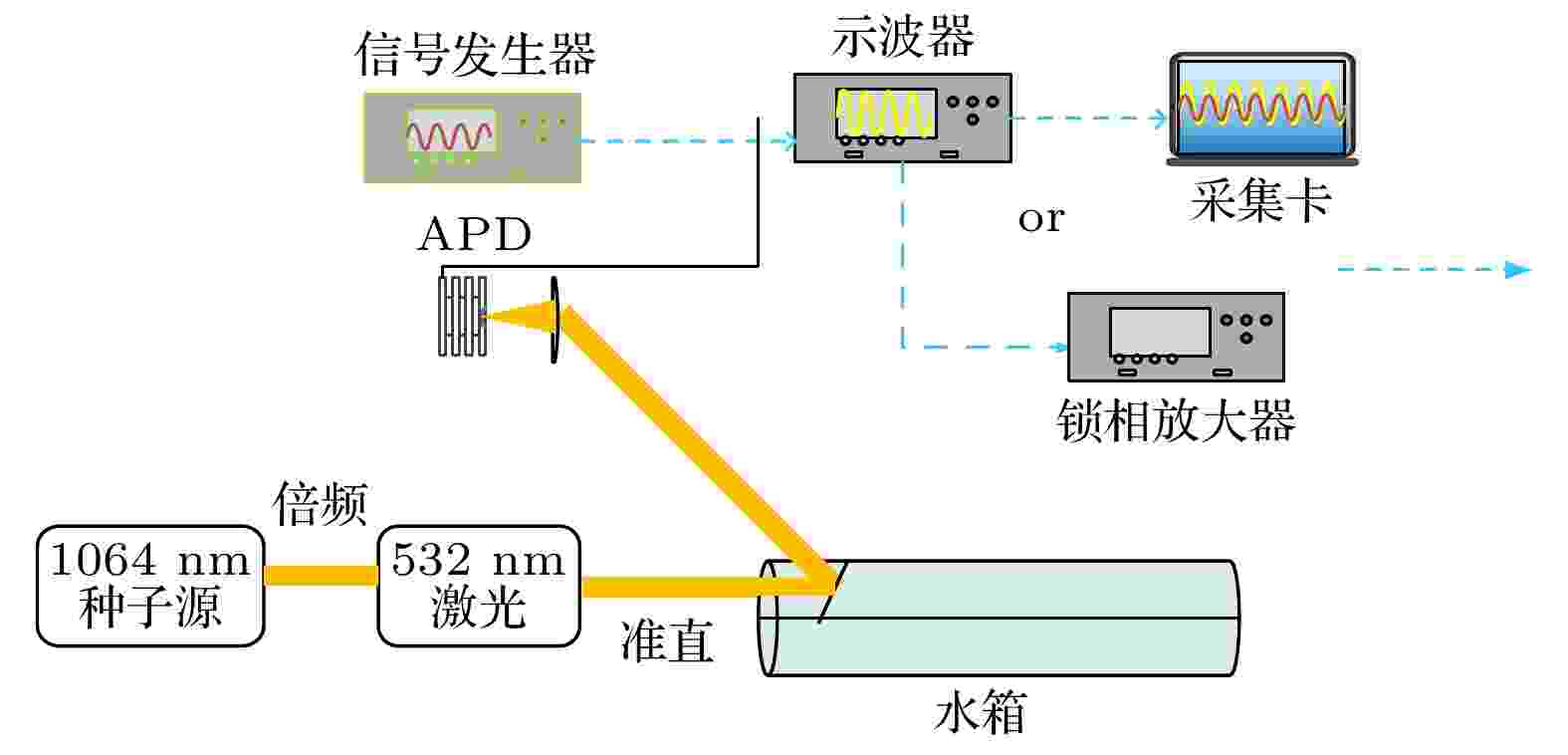
2021, 70 (18): 184205.
doi: 10.7498/aps.70.20210569
Abstract +
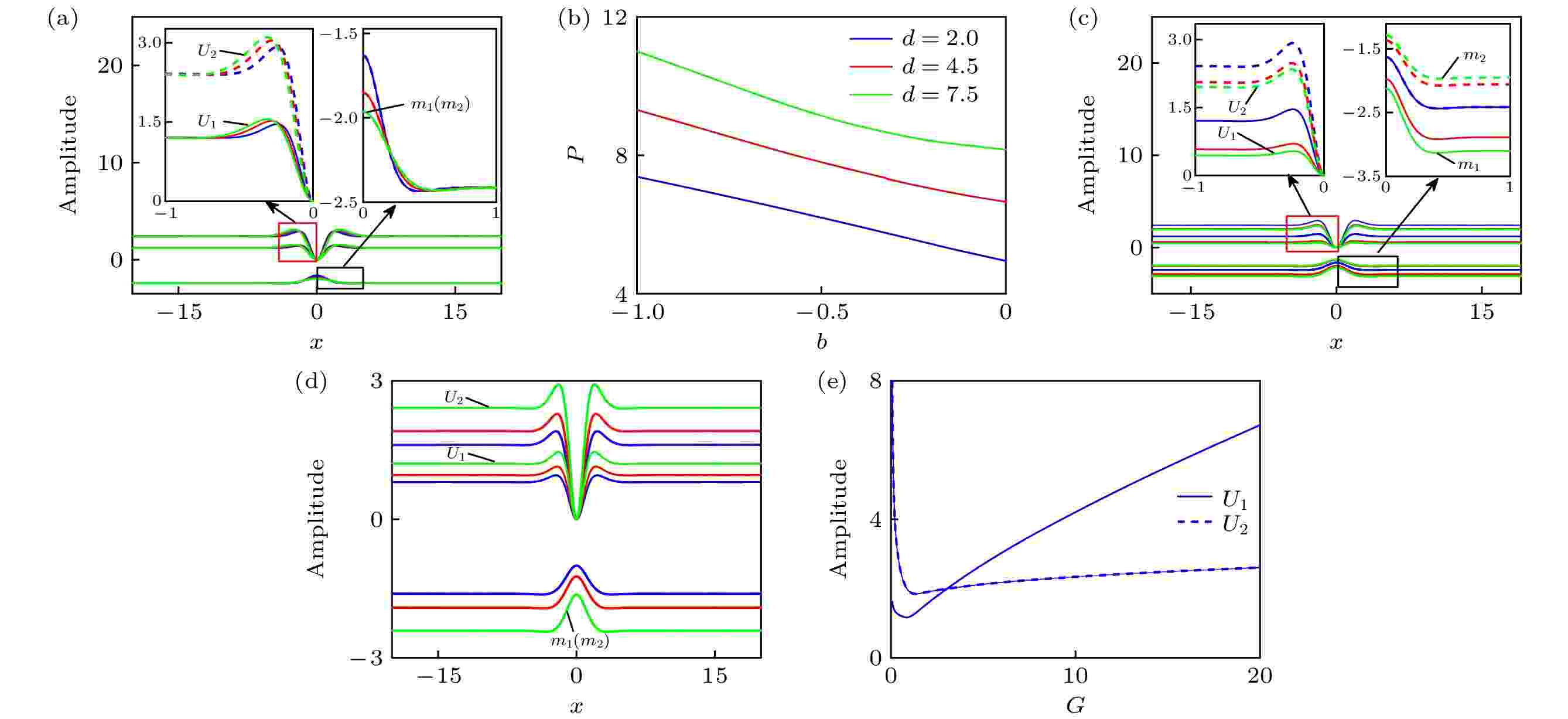
2021, 70 (18): 184206.
doi: 10.7498/aps.70.20210275
Abstract +
The characteristics of fundamental and mutipole dark solitons in the nonlocal nonlinear couplers are studied through numerical simulation in this work. Firstly, the fundamental dark solitons with different parameters are obtained by the Newton iteration. It is found that the amplitude and beam width of the ground state dark soliton increase with the enhancement of the nonlocality degree. As the nonlinear parameters increase or the propagation constant decreases, the amplitude of the fundamental dark soliton increases and the beam width decreases. The power of the fundamental dark soliton increases with the nonlocality degree and nonlinear parameters increasing, and decreases with the propagation constant increasing. The refractive index induced by the light field decreases with the nonlocality degree increasing and the propagation constant decreasing. The amplitudes of the two components of the fundamental dark soliton can be identical by adjusting the coupling coefficient. These numerical results are also verified in the case of multipole dark solitons. Secondly, the transmission stability of fundamental and mutipole dark solitons are studied. The stability of dark soliton is verified by the linear stability analysis and fractional Fourier evolution. It is found that the fundamental dark solitons are stable in their existing regions, while the stable region of the multipolar dark solitons depends on the nonlocality degree and the propagation constant. Finally, these different types of dark dipole solitons and dark tripole solitons are obtained by changing different parameters, and their structures affect the stability of dark soliton. It is found that the multipole dark soliton with potential well is more stable than that with potential barrier. The refractive-index distribution dependent spacing between the adjacent multipole dark solitons favors their stability.

2021, 70 (18): 184207.
doi: 10.7498/aps.70.20210401
Abstract +
Integrated photonics has the advantages of miniaturization, low cost, stability and easy manipulation in comparison with bulk optics. However, as the scale and complexity of the chip increase, the calibration of cascaded phase shifters on-chip will be almost impossible. The time needed to calibrate the cascaded phase shifters with using conventional method increases exponentially with the number of cascades, and the maximum number of cascades achieved so far is only 5. In this paper, we propose a high-speed calibration method by which the calibration time increases only linearly with the number of cascades increasing, achieving an exponential acceleration. For N-cascaded phase shifters, the number of points scanned by each shifter is m, our method only needs to scan $ ({m}^{2}+m+1)N-1 $ points instead of $ {m}^{n} $ with using the proposed method. The main idea of this method is that we can calibrate phase shifters one by one via two-dimensional (2D) scanning. For example, for N-cascaded phase shifter, the calibration of phase shifter N can be realized by calibrating the 2D scanning phase shifter $ N-1 $ and the 2D scanning phase shifter N, and the calibration of phase shifter $ N-1 $ can be achieved by calibrating the 2D scanning phase shifter $ N-2 $ and the 2D scanning phase shifter $ N-1 $ , and so on. The 2D scanning phase shifter $ N-1 $ and the 2D scanning phase shifter N scan the phase shifter N by m points and then the current of phase shifter $ N-1 $ is changed to scan the phase shifter N. Whenever changing the current of phase shifter $ N-1 $ once, we can plot a curve of current-transmission. The lowest point of the curve changes with the change of the current phase shifter $ N-1 $ . When the lowest point of the curve takes a maximum value, that point is the 0 or π phase of phase shifter N. Similarly, when the lowest point of the curve takes a maximum value, that point is the $ -0.5{\rm{\pi }} $ or $ 0.5{\rm{\pi }} $ phase of phase shifter $ N-1 $ . Then we can calibrate all phase shifters by using this method, but each phase shifter has two possibilities. Then we can set a specific current of all phase shifters to finish the calibration. The different parameters are verified to see their effect on fidelity. It is found that small experimental error has little effect on fidelity. When $ m > 20 $ , the fidelity becomes approximately a constant. For every 1760 increase in N, the fidelity decreases by about 0.01%. The fidelity of 20-cascaded phase shifters is 99.8%. The splitting ratio of MMI may is not 50∶50 as designed because of chip processing errors. So, different splitting ratios are simulated and it is found that the splitting ratio affects the fidelity more seriously than other parameters. But our method works still well even when the splitting ratio is 45∶55, whose fidelity is 99.95% if we know the splitting ratio. The method will greatly expand the application scope of integrated quantum photonics.
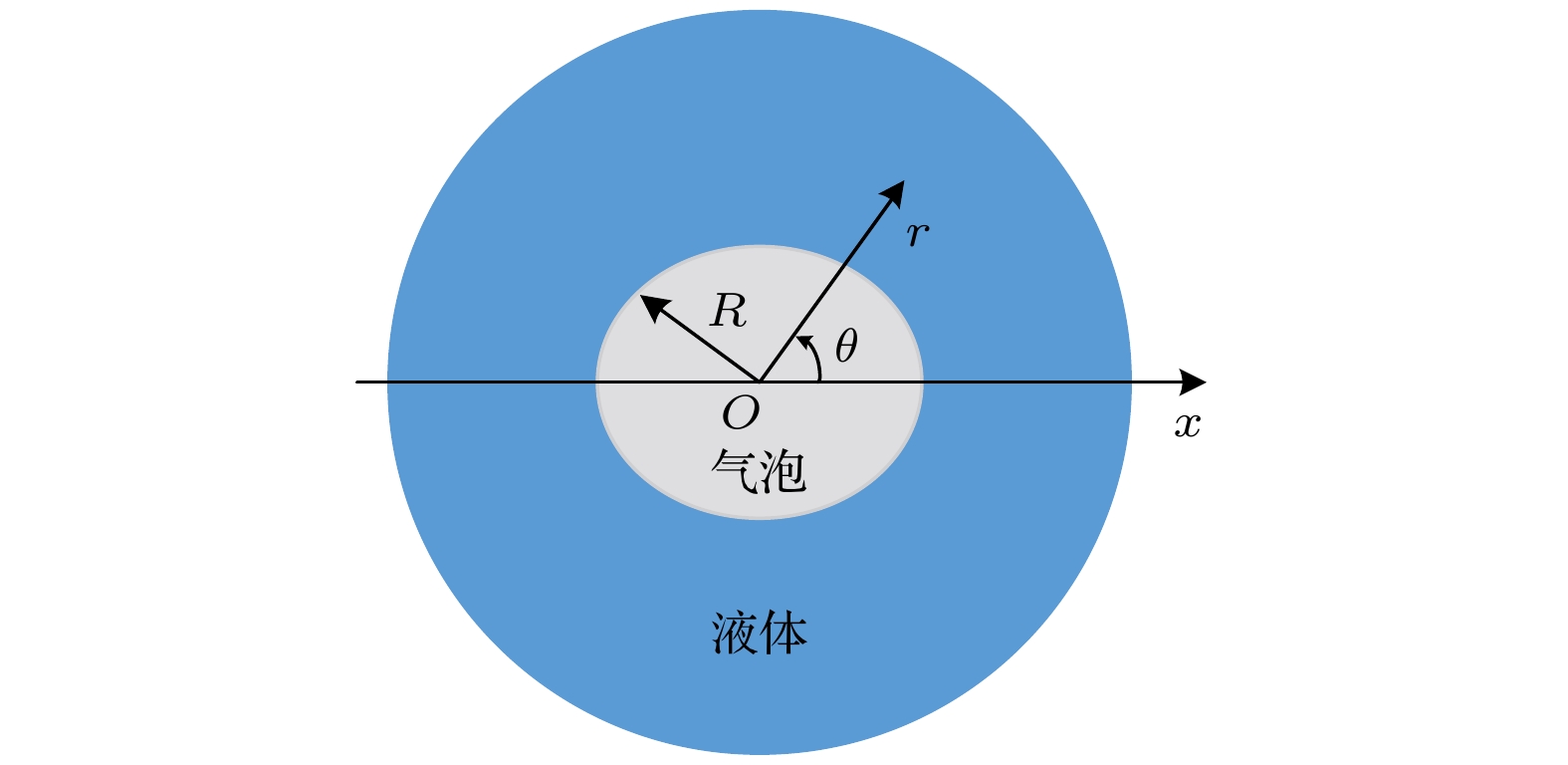
2021, 70 (18): 184301.
doi: 10.7498/aps.70.20210513
Abstract +
Based on the perturbation theory and generalized Bernoulli equation, the equations describing the radius, translation and deformation of a single gas bubble in ultrasonic field are derived. The evolutions of the radius, displacement and deformation of the bubble with time can be obtained by numerically calculating these equations. The calculation results show that when the initial radius of the bubble and the driving pressure both keep constant, the displacement and shape variable of the bubble increase with the augment of the initial translational velocity of the bubble’s center, and the non-spherical vibration of the bubble becomes more intense. However, the radial vibration of the bubble almost remains unchanged. When the initial translation velocity of the bubble is relatively small, the unstable region is concentrated only in the region of high driving sound pressure in the $R_{0}\text-p_{\rm a}$ phase diagram of the bubble. As the initial translational velocity increases, the region with small radius and driving sound pressure begins to show instability, and the overall unstable region gradually increases. In addition, a bubble presents different vibration characteristics at different positions in the acoustic standing wave field. The closer to the antinode of sound wave the bubble is, the greater the radial amplitude of the bubble’s vibration is. However, the variable of the translation and shape of the bubble are very small. The error between the plane fractions of the unstable region in the phase diagram of $R_{0}\text{-} p_ {\rm a}$ is less than 4%.

EDITOR'S SUGGESTION
2021, 70 (18): 184302.
doi: 10.7498/aps.70.20210712
Abstract +
The accidentally degenerate type-II Dirac points in sonic crystal has been realized recently. However, elastic phononic crystals with type-II Dirac points have not yet been explored. In this work, we design a two-dimensional phononic crystal plate in square lattice with type-II Dirac points for elastic waves. The type-II Dirac points, different from the type-I counterparts, have the tiled dispersions and thus the iso-frequency contours become crossed lines. By tuning structures to break the mirror symmetry, the degeneracies of the type-II Dirac points are lifted, leading to a band inversion. In order to have a further explanation, we also calculate the Berry curvatures of phononic crystals with opposite structure parameters, and it turns out that these two crystals hold opposite signs around the valley. The phononic crystal plates before and after the band inversion belong to different topological valley phases, whose direct consequence is that the topologically protected gapless interface states exist between two distinct topological phases. Topologically protected interface states are found by calculating the projected band structures of a supercell that contains two kinds of interfaces between two topological phases. Robustness of the interface transport is verified by comparing the transmission rate for perfect interface with that for defective interface. Moreover, owing to the special stress field distributions of the elastic plate waves, the boundaries of a single phononic crystal phase can similarly host the gapless boundary states, which is found by calculating the projected band structures of a supercell with a single phase, thus having two free boundaries on the edges. This paper extends the two-dimensional Dirac points and valley states in graphene-like systems to the type-II cases, and obtains in the same structure the gapless interface and boundary propagations. Owing to the simple design scheme of the structure, the phononic crystal plates can be fabricated and scaled to a small size. Our system provides a feasible way of constructing high-frequency elastic wave devices.

2021, 70 (18): 184701.
doi: 10.7498/aps.70.20210485
Abstract +
Drop dynamics at liquid surfaces is existent in nature and industry, which is of great value in studying droplet self-propulsion, surface coating, and drug delivery, and possesses great potential applications in microfluidics and biological process. Here, we analyze the role of Marangoni effect in the spontaneously driving system by studying the driving effect of a low surface tension liquid at the liquid substrate on another liquid. A three-phase liquid system is established to explore the liquid-driven spreading process, including non-volatile silicone oil as driving solvent, n-hexadecane as driven solvent, and sodium dodecyl sulfate (SDS) solution with different concentrations as aqueous substrates. The spreading process of n-hexadecane driven by silicone oil can be divided into two stages. N-hexadecane is first driven to form a thin rim, and then the rim breaks up into small liquid beads. Afterwards, the driving mechanism, spreading scaling laws and instability characteristic parameters of the liquid-driven spreading process are analyzed theoretically. The analysis of driving mechanism indicates that the differences in surface tension among silicone oil, n-hexadecane and SDS solution cause surface tension gradient at the liquid-liquid interface, which plays a crucial role in spreading the n-hexadecane. The results also demonstrate that the maximum spreading radius of n-hexadecane is affected by the concentration of the aqueous substrate. When the concentration of SDS solution is lower than the critical micelle concentration, the maximum spreading radius of n-hexadecane is proportional to the concentration of SDS solution. Meanwhile, the scaling law between the spreading radius R and time t driven by silicone oil conforms to the classical theoretical $ \mathrm{r}\mathrm{e}\mathrm{l}\mathrm{a}\mathrm{t}\mathrm{i}\mathrm{o}\mathrm{n}\;R\left(t\right)\propto {t}^{3/4} $ . In addition, the classical analysis model is used to explain the instability pattern of n-hexadecane breaking into small beads from rim in the liquid-driven spreading process, which is called Rayleigh-Plateau instability. The fastest instability wavelength $ {\lambda }_{\mathrm{s}} $ and the constant radius $ {r}_{\mathrm{c}} $ of the n-hexadecane liquid rim are related by $ {\lambda }_{\mathrm{s}}\approx 9{r}_{\mathrm{c}} $ . Our results prove the applicability of the spreading scaling law to the liquid-driven spreading process, and also help to understand in depth the mechanism of the liquid-driven spreading and the instability pattern in the spreading process.
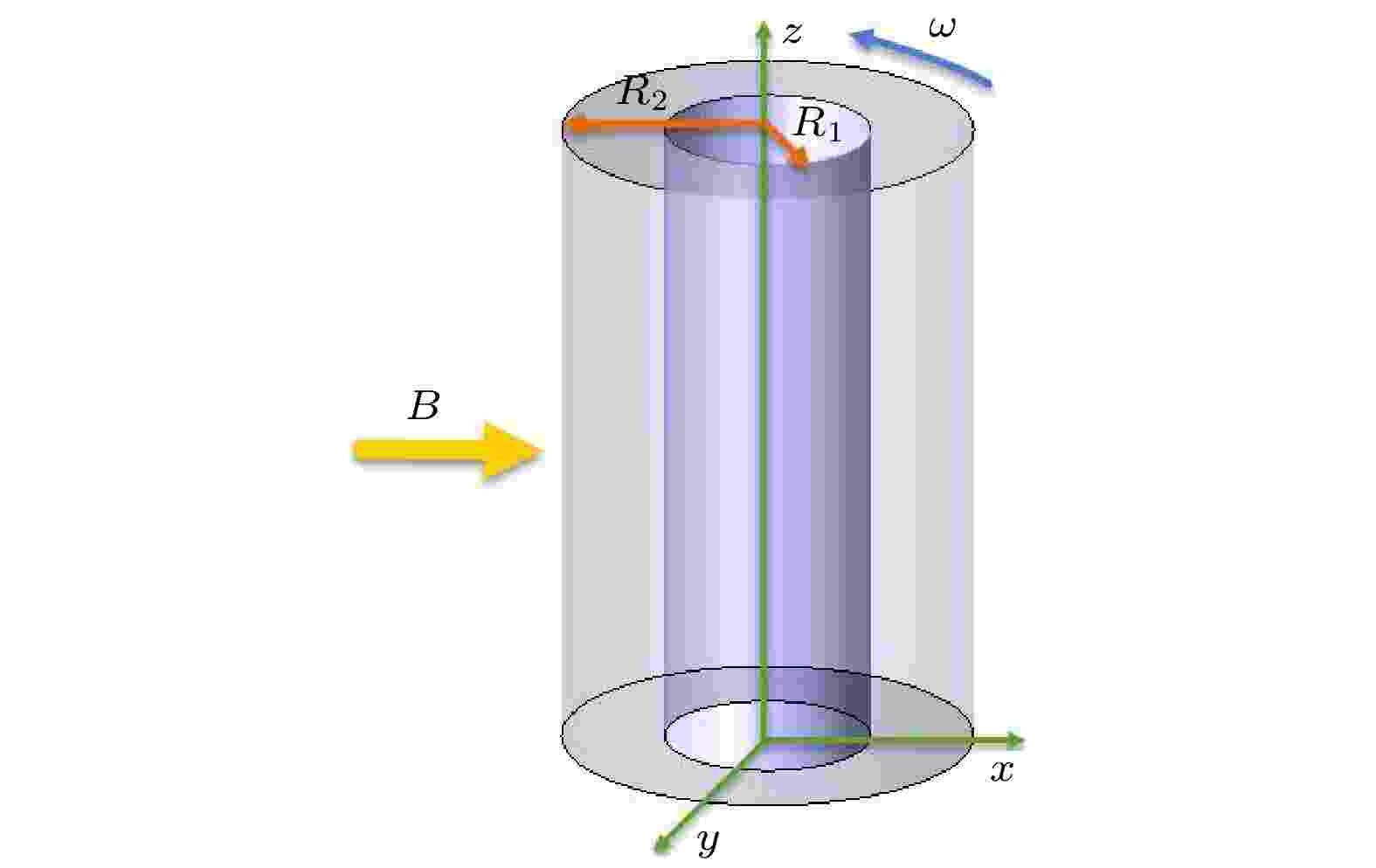
2021, 70 (18): 184702.
doi: 10.7498/aps.70.20210389
Abstract +
By the large eddy simulation method, the turbulent Taylor-Couette flow of conducting fluid under a homogenous transverse magnetic field is investigated through using the computational fluid dynamic software ANSYS Fluent 17.0. The flow is confined between two infinitely long cylinders, thus a periodic boundary condition is imposed in the axial direction. The inner cylinder rotates while the outer one is at rest, and their radius ratio is 1/2. Two Reynolds numbers of 3000 and 5000 are considered in the simulations, and the Hartmann number is varied from 0 to 50. In the present study, we assume a lower magnetic Reynolds number $Re_{\rm m} \ll 1$ , i.e., the influence of the induced magnetic field on the flow is negligible in comparison with the imposed magnetic field. The evolution of Taylor vortices, velocity profile of mean flow, and turbulent kinetic energy distribution under the transverse magnetic field are analyzed and compared with the results of the axial magnetic field counterpart. It shows that the imposed magnetic field has a significant damping effect on the Taylor-Couette flow. The twisted Taylor vortices break into small-scale vortex structures under the transverse magnetic field and they arrange themselves along the magnetic field. The fluctuations which are perpendicular to the magnetic field are suppressed effectively, while the one which is parallel to the magnetic field is nearly uninfluenced, resulting in quasi-two-dimensional elongated structure in the flow field. As anticipated, in a sufficiently strong magnetic field, the turbulent Taylor-Couette flow may eventually decay to a Couette laminar flow. In the outer cylinder and the area perpendicular to the direction of the magnetic field, the suppression effect is even stronger than those in any other places and fewer vortices are observed in the simulations. The turbulent kinetic energy is transferred firstly from large eddies to intermediate eddies, then to small eddies, and finally dissipated due to the viscous and Joule effect. As the Reynolds number increases, the suppression effect of the magnetic field weakens, and the flow behaves divergently in different areas of the apparatus. Compared with the axial magnetic field, the transverse magnetic field has a weak suppression effect on the flow field, and the profiles of related variables are obviously anisotropic.
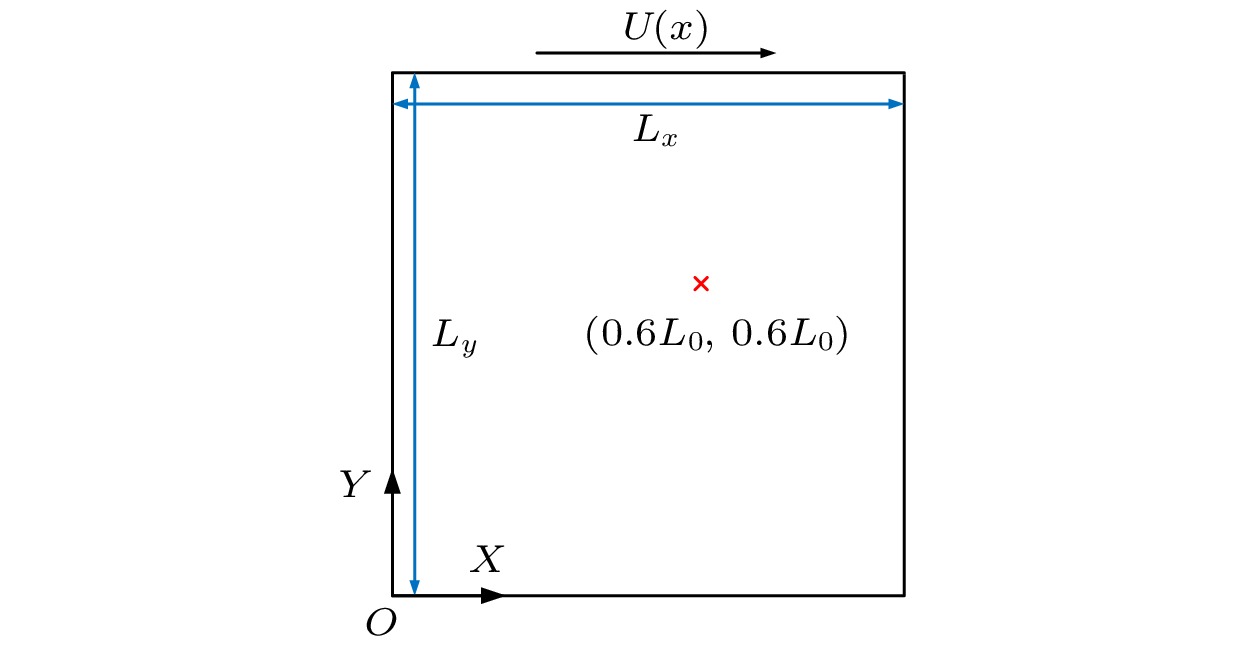
2021, 70 (18): 184703.
doi: 10.7498/aps.70.20210451
Abstract +
Studying transitions from laminar to turbulence of non-Newtonian fluids can provide a theoretical basis to further mediate their dynamic properties. Compared with Newtonian fluids, transitions of non-Newtonian fluids turning are less focused, thus being lack of good predictions of the critical Reynolds number (Re) corresponding to the first Hopf bifurcation. In this study, we employ the lattice Boltzmann method as the core solver to simulate two-dimensional lid-driven flows of a typical non-Newtonian fluid modeled by the power rheology law. Results show that the critical Re of shear-thinning (5496) and shear-thickening fluids (11546) are distinct from that of Newtonian fluids (7835). Moreover, when Re is slightly larger than the critical one, temporal variations of velocity components at the monitor point all show a periodic trend. Before transition of the flow filed, the velocity components show a horizontal straight line, and after transition , the velocity components fluctuate greatly and irregularly. Through fast Fourier transform for the velocity components, it is noted that the velocity has a dominant frequency and a harmonic frequency when Re is marginally larger than the critical one. Besides, the velocity is steady before transition of flow filed, so it appears as a point on the frequency spectrum. As the flow filed turns to be turbulent, the frequency spectrum of the velocity component appears multispectral. Different from a single point in the velocity phase diagram before transition, the velocity phase diagram after transition forms a smooth and closed curve, whose area is also increasing as Re increases. The center point of the curve moves along a certain direction, while movement directions of different center points are different. Proper orthogonal decompositions for the velocity and vorticity field reveal that the first two modes, in all types of fluids, are the dominant modes when Re is close to the critical one, with energy, occupying more than 95% the whole energy. In addition, for one type of fluid, the dominant modes at different Re values have similar structures. Results of the first and second modes of velocity field show that the modal peak is mainly distributed in vicinity of the cavity wall.
PHYSICS OF GASES, PLASMAS, AND ELECTRIC DISCHARGES
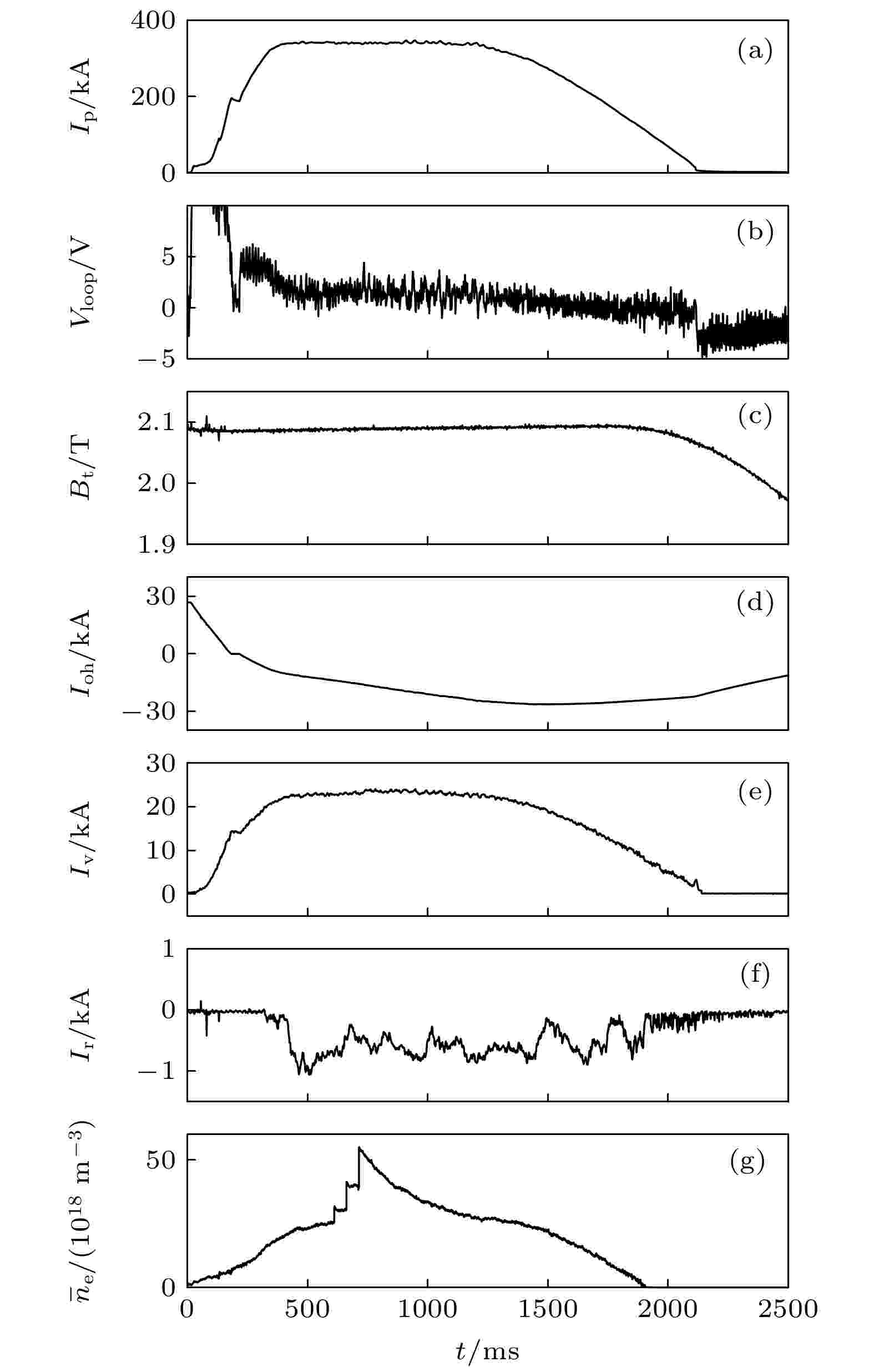
2021, 70 (18): 185201.
doi: 10.7498/aps.70.20210641
Abstract +
The tokamak with weak or negative magnetic shear and internal transport barrier (ITB) is considered to be the most promising approach to improving fusion performance. The hollow current density profile, as well as the reversed q profile (negative magnetic shear), is one of the key conditions for improving core confinement in advanced tokamak schemes. In the Huanliuqi 2A (HL-2A) experiment, a hollow current distribution with a discharge duration of about 100 ms is successfully achieved by injecting the pellets in the Ohmic discharge. The discharge is characteristic of circular equilibrium configuration and three frozen pellets are injected continuously at three different time moments. As a result, the hollow current profiles are formed in the plasma with weak hollow electron temperature in the core region. At the same time, the hollow currents are combined with the reversed magnetic shear profiles. Because the power of Ohmic heating is not so high and there is no external auxiliary heating, we can see only a trend of the formation of weak internal transport barrier in the stable hollow current discharge stage. However, the electron thermal diffusivity decreases significantly after the pellets have been injected. The deep injection of frozen pellets improves the energy confinement. The enhancement of plasma performance is due to the peaked electron density profile in the center, caused by pellet injection and the negative magnetic shear in the plasma center. It is concluded that the electron density profile peaked highly in the core plasma, caused by pellet injection, is beneficial to the improvement of particle confinement and plays an important role in enhancing the energy confinement. In addition, it is also demonstrated that, in general, during a hollow current discharge, the poloidal beta $ {\beta }_{\mathrm{p}} $ value and normalized beta $ {\beta }_{\mathrm{N}} $ value are both obviously low although the reversed magnetic shear is conducive to stabilizing ballooning modes and weakening the drift instabilities. However, comparing with the hollow current profile, the plasma with peaked current profile is very beneficial to the improvement of beta limit. In order to improve the $ {\beta }_{\mathrm{N}} $ limit, a conductive wall is necessary to be placed near the plasma boundary. The results of HL-2A pellet injection experiments present a possibility of obtaining high parameter discharge on a limiter tokamak.
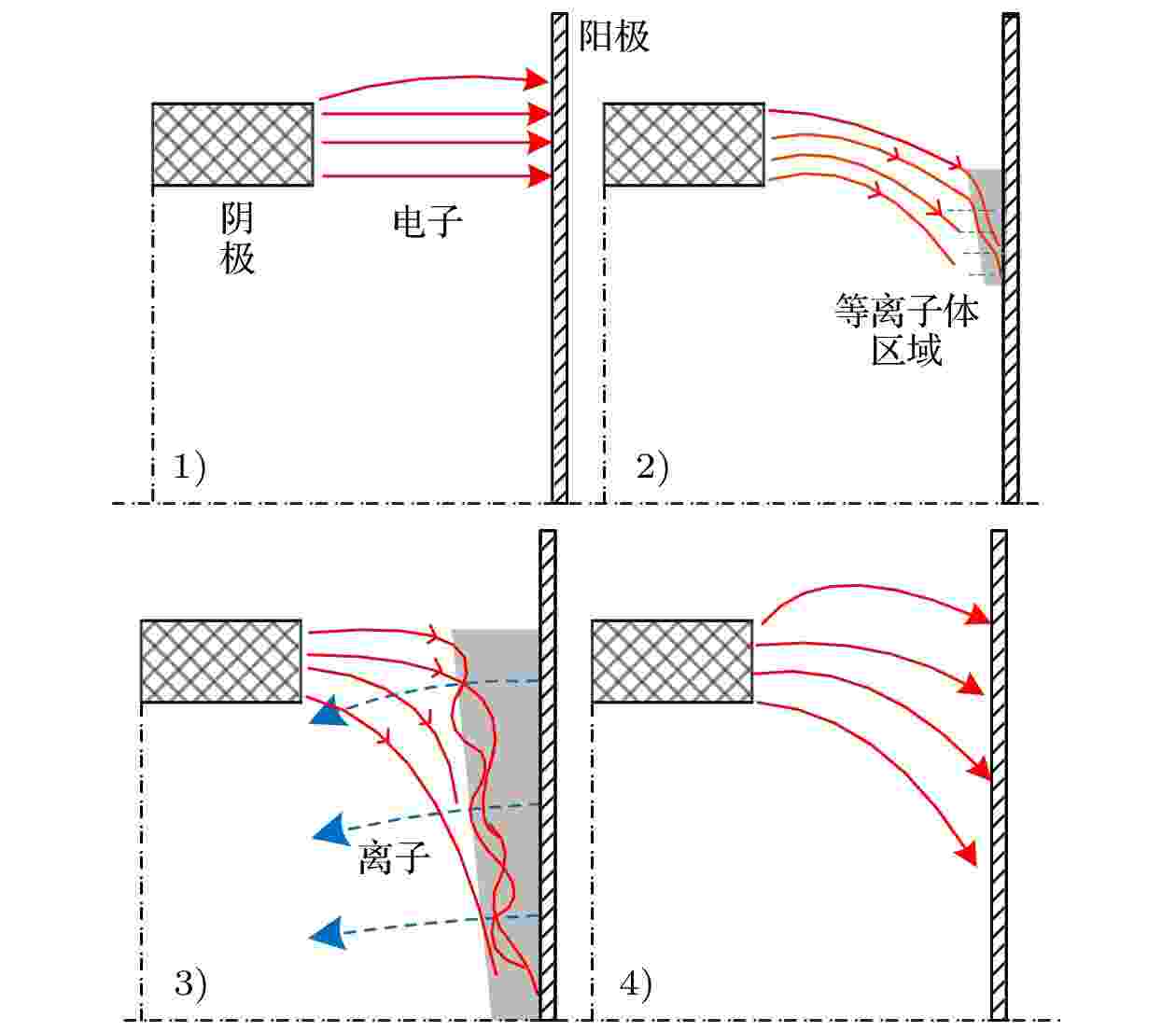
2021, 70 (18): 185202.
doi: 10.7498/aps.70.20210472
Abstract +
Electron beam pinching is a common physical phenomenon in the working process of high-current electron beam diodes. The radial collapse velocity (Va) of the beam is an important index to determine the beam pinching and the working characteristics of the diode. The current research methods are based on optical diagnosis and theoretical estimation formulas for a specific diode. The radial collapse velocity of Qiangguang-I accelerator’s tight-pinched short γ diode can be obtained by the following three methods in this paper: 1) a theoretical formula, which is used to calculate the radial collapse velocity on the basis of the existing research results, and can very quickly determine the pinching situation because in this case this formula just needs a diode pinching current; 2) the method of calculating Va, which is established based on particle-in-cell simulation. The simulation model includes the anode ion current, thus can simulate the pinching of electron beam more precisely; 3) a method of calculating Va, which is given by measuring the pinch center offset and the γ-ray PIN waveform, because the Qiangguang-I γ diode is inconvenient for optical diagnosis. The radial collapse velocities obtained by the above three methods are 8.43, 8.70 and 7.89 cm2/ns respectively, and the relative difference among the three methods is < 10%. The third method obtains a slightly smaller value because the ion current assumed in the theory and simulation is H+. The ion current composition in the actual diode is complex, the diffusion speed is slower, then the radial collapse velocity is smaller. Compared with the typical Va value (2–4 cm2/ns) of the Gamble II accelerator diode given by the Blaugrund team, the Va value of the short γ diode of the Qiangguang-I accelerator is nearly doubled. The diode on Qiangguang-I, which works after a plasma opening switch (POS), has a very short rising time (less than 10 ns), and pinches quickly. In contrast, the rising time of the Gamble II accelerator diode is about 40 ns, which is different from the working status of the Qiangguang-I diode. This paper provides a new way to study the radial collapse velocity of high-current diodes.
CONDENSED MATTER: STRUCTURAL, MECHANICAL, AND THERMAL PROPERTIES
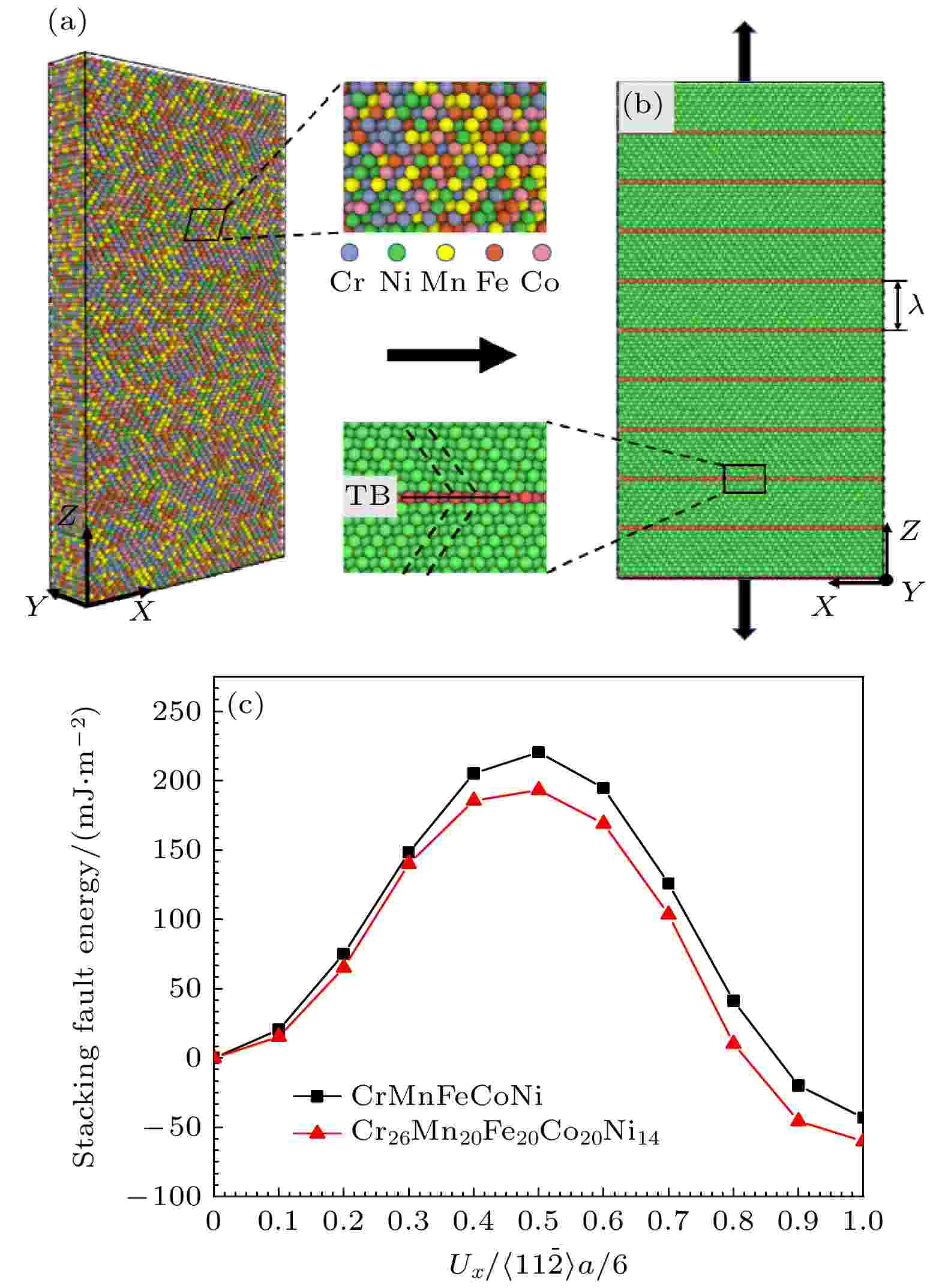
2021, 70 (18): 186201.
doi: 10.7498/aps.70.20210324
Abstract +
The high-entropy alloys break through the traditional alloy structure and present unique and superior mechanical properties. However, the potential deformation mechanism of high-entropy alloy, which is regarded as a new member of alloy families in recent years, needs to be further investigated. In this paper, the mechanical properties of the nano-twin Cr26Mn20Fe20Co20Ni14 high-entropy alloy under tensile loading are studied by molecular dynamics simulation, and the effect of twin boundary on the deformation behavior of nano-twin Cr26Mn20Fe20Co20Ni14 high-entropy alloy is studied on an atomic level. The results show that the yield strength of the nano-twin Cr26Mn20Fe20Co20Ni14 high-entropy alloy increases with twin boundary spacing decreasing, presenting a Hell-Petch relationship. However, there is a critical value of the twin boundary spacing, which makes the sensitivity of the yield strength of the high-entropy alloy to the twin boundary spacing change significantly before and after this value. The results also indicate that the deformation mechanism of nano-twin Cr26Mn20Fe20Co20Ni14 high-entropy alloy changes from dislocation slip to amorphous phase transition with the decrease of twin boundary spacing. The research results of this paper have a certain reference value and guidance significance for designing and preparing high-performance high-entropy alloys.

2021, 70 (18): 186202.
doi: 10.7498/aps.70.20210457
Abstract +

COVER ARTICLE
2021, 70 (18): 186801.
doi: 10.7498/aps.70.20210783
Abstract +
The interplay between non-trivial band topology and magnetic order can induce exotic quantum phenomena, such as the quantum anomalous Hall effect and axion insulator state. A prevalent approach to realizing such topological states is either by magnetic doping or through heterostructure engineering, while the former will bring in inhomogeneity and the latter requires complex procedures. Intrinsic magnetic topological insulators are expected to avoid the aforementioned disadvantages, which is of great significance in both studying and practically using these exotic quantum phenomena. Recently, a Zintl compound EuIn2As2 is predicted to be an intrinsic antiferromagnetic axion insulator. The bulk magnetic order of EuIn2As2 has been reported in a lot of experiments, while the topological nature has not yet been confirmed. The surface properties of intrinsic magnetic topological insulators play an important role in the interplay between magnetic order and non-trivial surface state. Here in this work, we study the surface structure and electronic property of EuIn2As2 single crystal by using scanning tunneling microscopy/spectroscopy (STM/S) and non-contact atomic force microscopy (NC-AFM). Considering the strength of bonds, the easy cleavage plane of the crystals possibly lies between In-In layers or between Eu-As layers. The STM topographies show that the cleaved surface is dominated by a striped pattern. And the dominated step height is an integer multiple of c/2, which implies that only one kind of cleavage plane is preferred. Atomic-resolved surface topographies show that the striped pattern is the $ 1\times 2 $ surface reconstruction with 50% coverage. Hence an In-terminated surface which will be 100% coverage is ruled out. The spatial evolution of STS near vacancies on the striped pattern shows a hole-doping feature. All of these results reveal that the striped pattern is the $ 1\times 2 $ surface reconstruction of the Eu terminated surface with 50% coverage. Using the STS, we measure the local densities of states on the striped surface at various temperatures. We find that there is an asymmetric valley-peak feature in the density of states near the Fermi energy at 4 K, which is gradually weakened with increasing temperature, and disappears above the antiferromagnetic Néel temperature, indicating that the asymmetric valley-peak feature is closely related to the antiferromagnetic order. Besides, a maze-like pattern is observed occasionally near some step edges. The STM topographies show atoms both on bright and dark stripes of the maze-like pattern, which form a whole hexagonal lattice. And the NC-AFM images show that the maze-like pattern is about 1 Å higher than the Eu terminated striped pattern. Based on these results, the maze-like pattern can be explained as the buckled Eu surface with 100% coverage. These results provide important information for understanding the surface electronic band structure and topological nature of EuIn2As2.
CONDENSED MATTER: ELECTRONIC STRUCTURE, ELECTRICAL, MAGNETIC, AND OPTICAL PROPERTIES
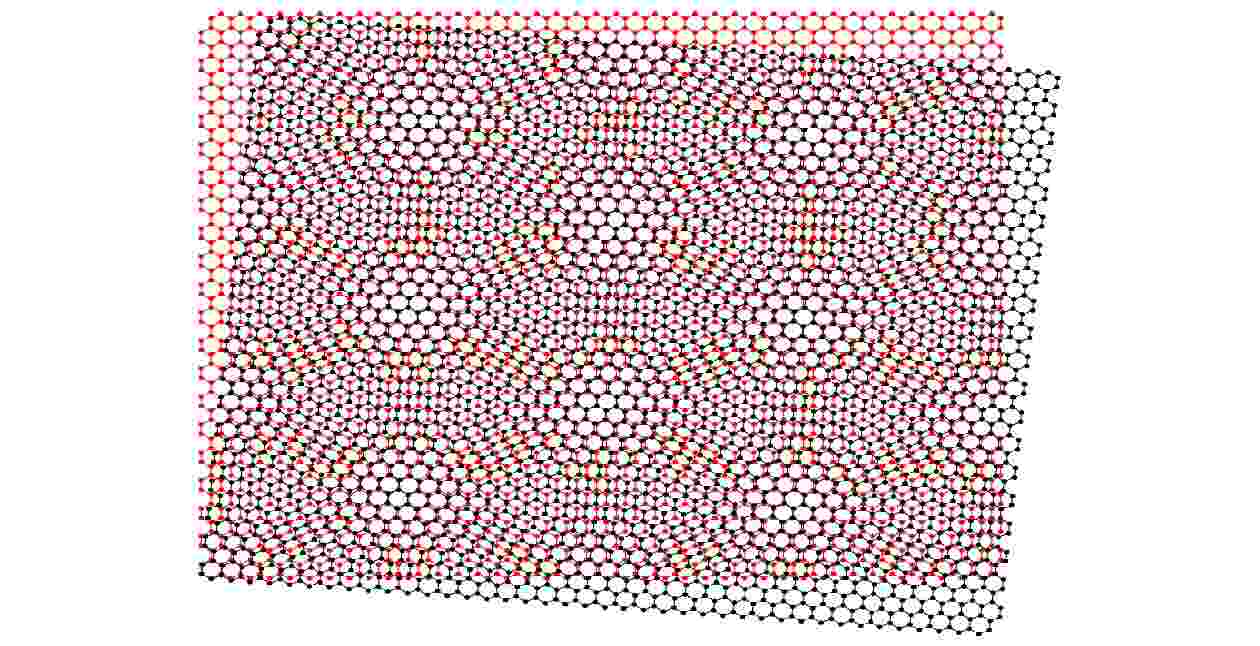
EDITOR'S SUGGESTION
2021, 70 (18): 187301.
doi: 10.7498/aps.70.20210110
Abstract +

2021, 70 (18): 187302.
doi: 10.7498/aps.70.20210613
Abstract +
In order to regulate thermal transfer characteristics of graphene/silicon carbide heterogeneous interface, the influence of temperature, size and material defect rate on thermal conductance of heterogeneous interface are studied by the non-equilibrium molecular dynamics method. The sandwich model of graphene/silicon carbide heterostructures with different lengths and thickness is built by Material Studio. The reasons for the change of thermal conductance are analyzed from the two aspects of phonon density of states and phonon participation rate. When the system temperature is below the Debye temperature of silicon carbide and graphene, the quantum corrections is used to calculate the thermal conductance of heterostructure in the paper. The results show that the thermal conductance increases with the increase of temperature under both interfacial forces, but the thermal conductance of heterogeneous interface under covalent bond is higher than under van der Waals force. The main reason is that the density of states of graphene in a range of 10—30 THz increases significantly with the increase of temperature. The thermal conductance of heterogeneous interface decreases with the increase of silicon carbide layers, and decreases by 30.5% when the number of silicon carbide layers increases from 10 to 20. The thermal conductance of heterostructure is the lowest in the thermal conductances of 4 layers, it is considered that more phonons are transferred from local to delocalized mode in the middle and low frequency band. The introduction of vacancy defects can effectively improve the interface thermal conductance. At different temperatures, the interfacial thermal conductance first increases and then decreases with the increase of graphene defects, and the defect rate when the interfacial thermal conductance reaches the maximum value and the degree of interfacial thermal conductance decrease after reaching the maximum value is related to temperature. When the defect rate of silicon carbide and graphene are 20% and 35% respectively at 300 K, the interface thermal conductance reaches a maximum value. When the temperature is 900 K, the thermal conductance of graphene/silicon carbide heterogeneous interface reaches a maximum value when the defect rate is 30%. It is considered that the introduction of defects will hinder the medium frequency phonons from realizing the heat transport. The results show that the size effect and vacancy defect can be utilized to modify the heterogeneous interface, which is beneficial to the design and thermal management of the third-generation semiconductor micro-nano devices.

EDITOR'S SUGGESTION
2021, 70 (18): 187303.
doi: 10.7498/aps.70.20210290
Abstract +
Optical nonlinear effect plays an important role in optical communication, optical detection, quantum information and other areas. However, it is constrained by the weakness of the nonlinear optical response of the common materials. The enhancement of the optical nonlinear response on a nanoscale becomes a critical challenge. Over the years, several ways to enhance the optical nonlinear effects have been suggested. In fact, these technologies can slightly enhance the optical nonlinear response. Recently, some research groups focused on the materials with vanished permittivity, which is called epsilon-near-zero (ENZ) material, showing that it can exhibit large optical nonlinearity due to the field enhancement in the material of this type. However, the ENZ material only holds a large optical nonlinear response in a limited spectral range. In order to overcome this limitation, here in this paper we report the ENZ mode which is excited by the ITO film and strongly coupled to the gap surface plasmons excited by the metal-dielectric-metal structure. To acquire the nonlinear refractive index n2, we first calculate the ITO permittivity through the Drude-Lorentz model and find the wavelength of the ENZ material. Then we calculate the time-dependent electron temperature and lattice temperature of ITO by the two-temperature model. According to the elevated electron temperature, we can calculate the plasma frequency ${\omega _{\rm p}}$ , and by taking it into the Drude-Lorentz model, we can obtain a new permittivity of ITO compared with the initial one. Finally, we can calculate the variation of the refractive index $ \Delta n $ , and the nonlinear refractive index $ {n_2} = \Delta n/{I_0} $ . In this paper, our coupled structure exhibits a broadband (~1000 nm bandwidth) enhancement of the nonlinear optical effect in the near-infrared spectrum, a maximum nonlinear refractive index n2 as large as 3.02 cm2·GW–1, which is nearly 3 orders larger than the previously reported nonlinear refractive index of bare ITO film. As a result, it is possible to realize a dramatically large variation of nonlinear refractive index under a low-power optical field. It is expected to be used in the nano photonic devices such as optical storage, all-optical switches, etc.
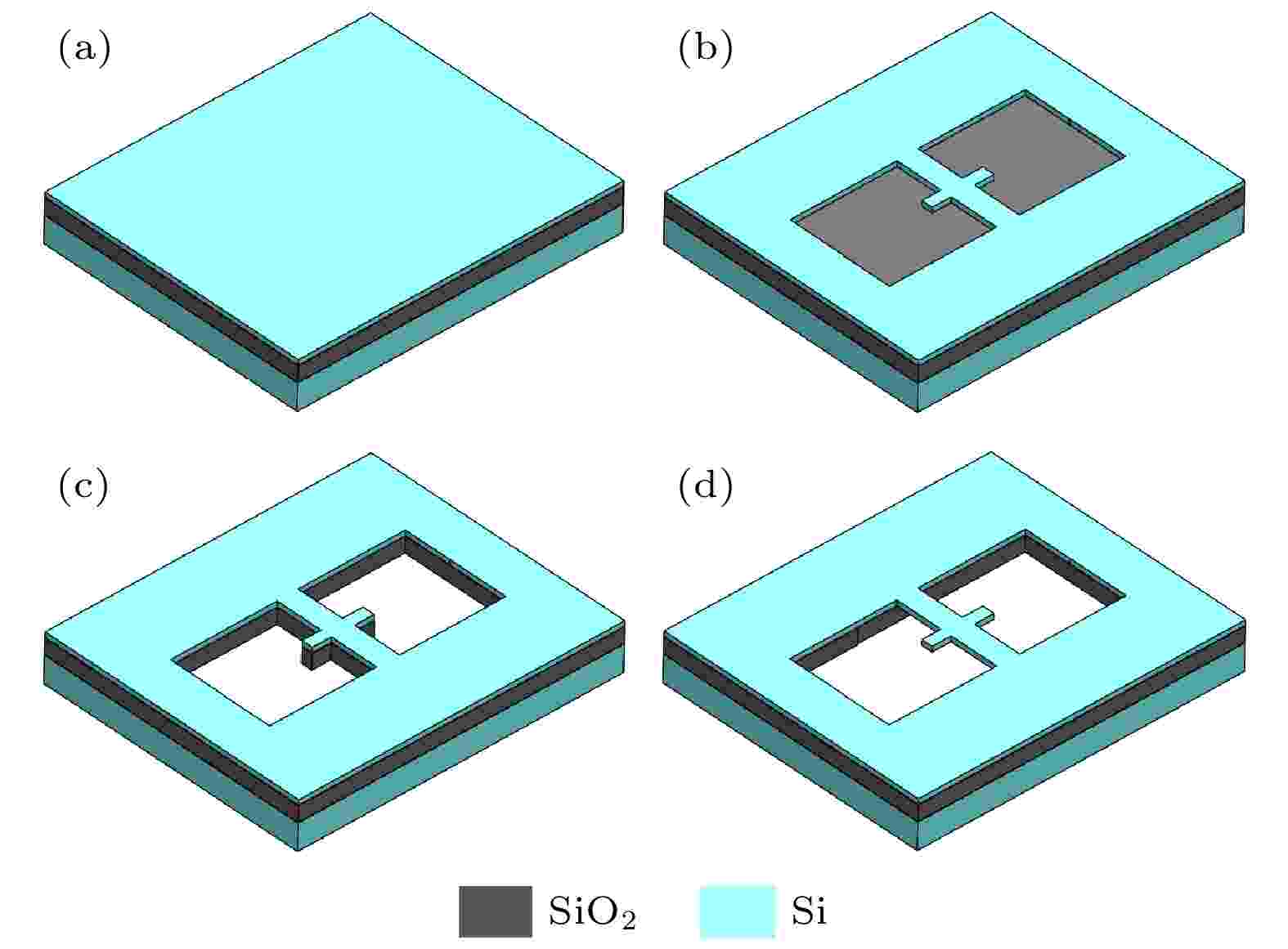
EDITOR'S SUGGESTION
2021, 70 (18): 187304.
doi: 10.7498/aps.70.20210801
Abstract +

2021, 70 (18): 187501.
doi: 10.7498/aps.70.20210507
Abstract +
The spin-wave coupling device is used as a connection unit to solve the connection problem between spin-wave devices. However, the current size is too large in comparison with the nano-scale process, which is caused by the low efficiency of the spin wave within it. Therefore, we propose the spin-wave directional coupler based on Y3Fe5O12-CoFeB coupling which can improve the current dilemma to a certain extent. By filling the gap layer of two spin-wave waveguides (Y3Fe5O12) placed in parallel with CoFeB material, it is found that the dispersion relationship of the spin wave changes in the data calculation of the micromagnetic simulation software Mumax3. The existence of CoFeB makes the transmission efficiency of the spin wave between the two waveguides higher than in the case without any filling, the enhancement effect is about 4 times where coupling length is reduced from the original 2000 nm to 500 nm, which is conducive to the miniaturization and integration of the spin-wave directional coupler design. From the perspective of the entire device, further analysis indicates that owing to the high saturation magnetization of CoFeB (approximately 8 times that of Y3Fe5O12), the effective field in the Y3Fe5O12-CoFeB directional coupler is greatly enhanced, which leads the spin wave dispersion curve in the waveguide to change. At the same time, the energy of the entire system also increases several times, which is mainly caused by the increase of dipole energy and exchange energy. Then a greater contribution of dipole energy is obtained by changing the size of the device. After that, we study the relationship between the coupling length and the device size and the external magnetic field, then draw a general rule which can play a role in designing any directional couplers with similar structures. Finally, our view points are given from the different spin wave excitation frequencies, gap layer filling materials, internal roughness of the directional coupler, and spin wave lifetime by considering the problems that may occur in practical applications with the Y3Fe5O12-CoFeB directional coupler. In conclusion, our proposed Y3Fe5O12-CoFeB directional coupler structure can effectively enhance the coupling efficiency, and it can also provide a new idea for the application of the interaction between composite materials.

2021, 70 (18): 187701.
doi: 10.7498/aps.70.20210810
Abstract +
In order to continue Moore’s Law, the reducing of power consumption is concerned by many researchers, and the discovery of ferronegative negative capacitance effect (NCE) provides a solution. Strain engineering has been widely studied as an effective means to regulate the physical properties of ferroelectric thin films. But the relevant mechanism of strain to ferroelectric negative capacitance regulation is not clear. Recently, the experimental results have shown that it is possible to stabilize the transient NCE in resistance-ferroelectric networks. In this work, we use the Landau-Khalatnikov theory to study the microscopic domain evolution and the influence of strain and temperature on NCE in a ferroelectric film. It is shown that compressive strain enhances NCE while NCE becomes weaker under a tensile strain. However, a larger compressive strain will give rise to a higher coercive voltage that hinders the NCE from forming. In addition, under a certain strain, the NCE becomes stronger at lower temperature. This work provides the theoretical basis for designing the negative capacitance devices and scaling towards nanoscale dimensions in future.

2021, 70 (18): 187702.
doi: 10.7498/aps.70.20210554
Abstract +
Quantum dot-sensitized solar cells have gained rapid development which could produce potential applications. Although they have a theoretical photoelectric conversion efficiency of 44%, there is still a considerable gap in comparison with corresponding practical solar cells, which is mainly due to the fact that the interface transfer, stability and efficiency improvement are still facing some problems. In particular, the carrier recombination loss at the cell interface seriously hinders the quantum dot-sensitized solar cells from developing. In this work, an ultra-thin layer of InN prepared by plasma-enhanced atomic layer deposition is inserted into the FTO/TiO2 interface of the photoanode of CdSeTe based quantum dot-sensitized solar cells to improve the performance of the photoanode structure, and physical mechanism behind the device is discussed. We first investigate the effects of different deposition temperatures (170, 200 and 230 ℃) on the cell performance of InN films. While the InN ultra-thin layer is deposited at 200 ℃, an enhancement of 16.9% in conversion efficiency is achieved as compared with the reference group. Then, the effects of different thickness (5, 10, and 15 cycles) on the cell are investigated at a fixed deposition temperature of 200 ℃. Additionally, an improvement of fill factor for the device after an introduction of InN layer is observed. This enhancement is further convinced by an apparent reduction of series resistance extracted by the Nyquist curve. The significant increase in fill factor indicates that the introduction of InN accelerates the extraction, transfer and separation of electrons, and reduces the possibility of photon-generated carriers recombination. However, the insertion of InN deposition temperature and thickness have a certain range of enhancement in the cell performance, and further investigation of the mechanism will be carried out.
INTERDISCIPLINARY PHYSICS AND RELATED AREAS OF SCIENCE AND TECHNOLOGY

2021, 70 (18): 188101.
doi: 10.7498/aps.70.20210572
Abstract +
The simple and convenient metallic mask method is a significant method of preparing diamond nanostructures. The metallic mask method has poor repeatability and can not give the ideal results, because it is supported by no theory about formation of surface mental nanoparticles and its technological parameters are optimized by no experimental techniques that are expensive either. Aiming at the formation and performance of the diamond/Al interface, this paper adopts the first-principles to study the adsorption and migration behavior of Al atoms on the H-terminated diamond surface and the structure of the diamond/Al interface. The results show that the highest adsorption energy is at the T4 position, which is only 0.181 eV, through comparing the adsorption energies of Al atoms at the highly symmetrical positions (Top, Br, H3 and T4) on the surface of the H-terminated diamond (111). The adsorption energies at these different positions are similar and the maximum difference is only 0.019 eV. There is formed no chemical bond, although Al has partial charge transfer on the H-terminated surface through the analysis of differential charge density and worse layout distribution. This phenomenon can be considered as electrostatic adsorption. That is to say, the adsorption of Al atoms are physical adsorption. The smooth potential energy surface also makes it easier for Al atoms to migrate on the diamond surface. The calculation results reveal that the migration activation energies of the two possible migration paths (from T4 position to Br position and from T4 to Top position) are 0.011 eV and 0.026 eV respectively. The above results imply that the metal Al and diamond are mainly connected by weak force, so the adhesion work of the three diamond/Al interface structures is compared based on the geometric stacking structure. The results show that the adhesion work of the three interfaces is around 0. These results indicate that the stability of the diamond/Al interface is not high and the stable structure of the interface is easily destroyed when the external environment changes. This speculation can be confirmed in molecular dynamics. When the simulated temperature is 300 ℃, the liquefied metal Al obviously accumulates into spheres. According to the above research results, we deduce that the metallic mask method does not require high requirements for the relationship between the metal and the substrate material, which depends mainly on the surface topography of the base material. This research provides an important theoretical reference for understanding the formation mechanism of metal nanomasks.

2021, 70 (18): 188401.
doi: 10.7498/aps.70.20210674
Abstract +

2021, 70 (18): 188501.
doi: 10.7498/aps.70.20210486
Abstract +
Superconducting nanowire single photon detector (SNSPD) has been widely used in many fields such as quantum communication due to its extremely high detection efficiency, low dark count rate, high count rate, and low timing jitter. Compared with conventional single-photon detectors with planar structure, SNSPD is typically made a periodical meandering structure consisting of parallel straight nanowires. However, owing to its unique linear structure, the detection efficiency of SNSPD is dependent on the polarization state of incident light, thus limiting SNSPD’s applications in unconventional fiber links or other incoherent light detection. In this paper, a polarization-insensitive SNSPD with high detection efficiency is proposed based on the traditional meandering nanowire structure. A thin silicon film with a high refractive index is introduced as a cladding layer of nanowires to reduce the dielectric mismatch between the nanowire and its surroundings, thereby improving the optical absorption efficiency of nanowires to the transverse-magnetic (TM) polarized incident light. The cladding layer is designed as a sinusoidal-shaped grating structure to minimize the difference in optical absorption efficiency between the transverse electric (TE) polarized incident light and the TM polarized incident light in a wide wavelength range. In addition, the twin-layer nanowire structure and the dielectric mirror are used to improve the optical absorption efficiency of the device. Our simulation results show that with the optimal parameters, the optical absorption efficiency of nanowires to both of the TE polarized incident light and TM polarized incident light has a maximum of over 90% at 1550 nm, and the corresponding polarization extinction ratio is less than 1.22. The fabricated device possesses a maximum detection efficiency of 87% at 1605 nm and a polarization extinction ratio of 1.06. The measured detection efficiency exceeds 50% with a polarization extinction ratio less than 1.2 in a wavelength range from 1505 nm to 1630 nm. This work provides a reference for high-efficiency polarization-insensitive SNSPD in the future.

EDITOR'S SUGGESTION
2021, 70 (18): 188701.
doi: 10.7498/aps.70.20210897
Abstract +
The generating of vortex beams in the terahertz (THz) band attracts significant attention due to their applications in high-speed communication and high-resolution imaging. In this article, a novel reflective metasurface working in the THz band is designed to generate four vortex beams with different topological charges in different directions. The unit cell is designed based on the geometric phase, and it consists of two metallic (gold) layers and one dielectric layer in between. The top layer of the unit cell includes an elliptic patch and a circular ring, and the bottom layer of the unit cell is a metallic ground. The reflection efficiency of the unit cell is very high due to the presence of metallic ground. To break through the limitations of traditional methods, the metasurface is a good choice to generate beams that carry orbital angular momentum (OAM). Using the concept of geometric phase, the reflection phase of reflective circular polarization (CP) electromagnetic waves can be controlled in an ingenious way. Owing to the property of the geometric phase, inverse phase shift can be achieved for left-handed circular polarization and right-handed circular polarization waves. By utilizing this trait of geometric phase, one can decompose a linear polarization wave into two orthogonal circular polarization waves and control their properties respectively. By rotating the top layer of the unit cell, 360-degree phase shift and the phase distribution satisfying the requirement for generating the multi-beam multi-mode vortex beam can be achieved. In order to control the direction and the topological charge of each beam, based on the geometric phase, the theory of reflectarray and the phase composition principle, the phase distribution of the reflective metasurface is calculated to provide the phase compensation to make the vortex beams point to certain directions. It is worthwhile to point out that the method presented in this paper provides a way to generate complex multi-mode vortex beams in the THz band. The simulations and measurements show that the metasurface can generate four vortex beams with topological charges l = ± 1 and ± 2 in different directions in the THz band. These results also indicate that our design has great potential applications in wireless communication and high-resolution imaging.
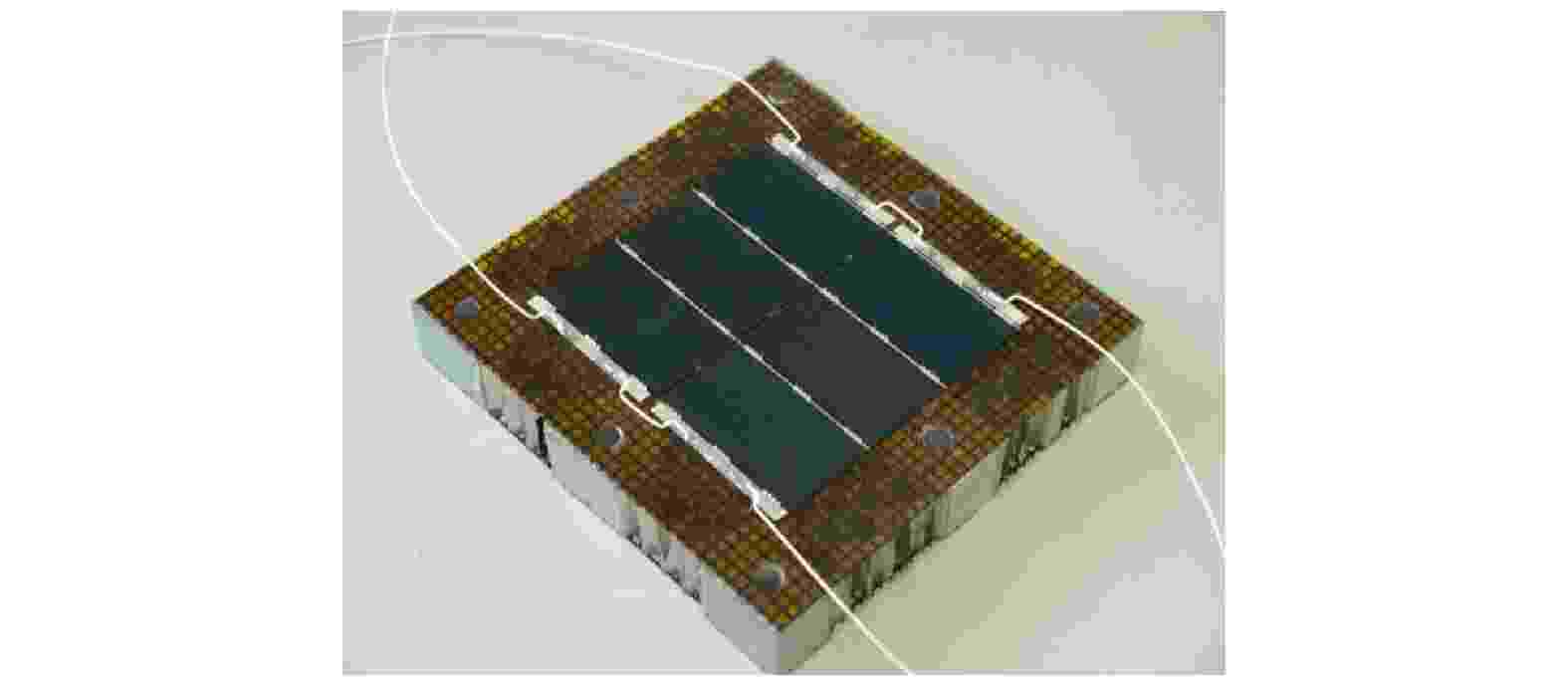
2021, 70 (18): 188801.
doi: 10.7498/aps.70.20210458
Abstract +
Solar array is a power source of spacecraft, which is often damaged by the impact of micrometeoroids and space debris, resulting in the decrease of output power of solar array. The degradation law of volt-ampere characteristic for spacecraft solar arrays under orbital debris hypervelocity impact is investigated by using a two-stage light gas gun. The volt-ampere characteristics of the solar arrays under different impact velocities, projectile diameters and impact positions are studied. A total of 12 shots are carried out, of which 5 shots are invalid due to the impact of the projectile carrier on the specimen, and 7 shots are valid. The experimental results show that the diameter, impact velocity, and impact position of the projectile all have a great influence on the volt-ampere characteristics, and the damage morphology generated by the ground simulation test is in line with the in-orbit flight test results. The relationship between the failure area of the solar arrays and the area of the spalling area, the perforation area, the kinetic energy of the projectile as well as the impact position are analyzed. It is found that the ratio of failure area to peeling area is between 7 and 37, and the ratio of failure area to perforation area is between 50 and 150. The failure area in the center of the solar cell is significantly larger than that on the edge or at the connection of the solar cell. Failure area of solar array $ \Delta {S}_{\mathrm{S}\mathrm{A}} $ and the cube root of kinetic energy E ($ E=\mathrm{\pi }\rho {d}^{3}{v}^{2}/12 $ ) is consistent. In order to establish the accurate equation of power loss area with projectile diameter and impact velocity, in this paper it is assumed that there is a power exponential relationship among them, and then solve the undetermined coefficient by the data fitting method. Finally, we establish the power loss $ {\Delta P}_{\mathrm{m}\mathrm{a}\mathrm{x}} $ equation and failure area $ \Delta {S}_{\mathrm{S}\mathrm{A}} $ equation suitable for domestic solar array. The equation will be $ {\Delta P}_{\mathrm{m}\mathrm{a}\mathrm{x}}=0.047d{v}^{2/3} $ , $ \Delta {S}_{\mathrm{S}\mathrm{A}}=260d{v}^{2/3} $ when the impact occurs in the center of the cell, and $ {\Delta P}_{\mathrm{m}\mathrm{a}\mathrm{x}}=0.033d{v}^{2/3} $ , $ \Delta {S}_{\mathrm{S}\mathrm{A}}=180d{v}^{2/3} $ when the impact occurs on the edge or at the connection of the solar cell. The prediction error of the equation is in a range of 13.3%, and the average deviation is 7.6%. This equation can be used to describe the function relationship between the power loss or failure area of the solar arrays and the diameter, impact velocity and impact position of the projectile under the condition of 0° impact angle. The research method in this paper can be used as a reference for the performance degradation assessment of Chinese spacecraft solar panels under the hypervelocity impact of orbital debris, the established power loss equation and failure area equation can predict the law of power decline and failure area of solar array caused by space debris, and the results have important application value for Chinese aerospace engineering.










































